 US Navy (1942-46) Light Cruisers: USS Cleveland, Columbia, Montpelier, Denver, Amsterdam, Santa Fe, Tallahassee, Birmingham, Mobile, Vincennes, Pasadena, Springfield, Topeka, New Haven, Huntington, Dayton, Wilmington, Biloxi, Houston, Providence, Manchester, Buffalo, Fargo, Vicksburg, Duluth, Newark, Miami, Astoria, Oklahoma City, Little Rock, Galveston, Youngstown, Buffalo, Newark, Amsterdam, Portsmouth, Wilkes-Barre, Atlanta, Dayton
US Navy (1942-46) Light Cruisers: USS Cleveland, Columbia, Montpelier, Denver, Amsterdam, Santa Fe, Tallahassee, Birmingham, Mobile, Vincennes, Pasadena, Springfield, Topeka, New Haven, Huntington, Dayton, Wilmington, Biloxi, Houston, Providence, Manchester, Buffalo, Fargo, Vicksburg, Duluth, Newark, Miami, Astoria, Oklahoma City, Little Rock, Galveston, Youngstown, Buffalo, Newark, Amsterdam, Portsmouth, Wilkes-Barre, Atlanta, DaytonThe WW2 standard USN light cruisers
The WW2 Cleveland-class light cruisers formed the most prolific serie in history*. With 29 ships completed out of 52 keels laid down, 13 cancellations and 10 conversion to fast aircraft carriers (USS Independence class). This was the great new standard for light cruisers, with a treaty-free tonnage of 12,000 tonnes standard. Among these two were completed on a different design, the USS Fargo and the USS Huntington, leading to an interesting sub-class designed in 1942 to improve the AA arc of fire with single funnel and revised superstructure.
They derived from the Brooklyn class, but their limited size and the need to eliminate extra weight made their protection insufficient, which were corrected on the new design. The original project was first defined in 1939, including 5 brand new semi-automated 6-in twin turrets, still in development. However as they were never ready on time, the Cleveland reverted on the proven triple turret design of the Booklyn class. The Clevelands were started between the 1st July 1940 and 20 February 1944, launched between 1st November 1941 and 22 March 1945. Some were completed too late: USS Manchester, Galveston, Fargo and Huntington participated in the Korean war instead. This large hulls reservoir led to the cold war conversion into hybrid missile cruisers. If some were discarded in the 1960s, many survived until 1970-78 while USS Little Rock has been preserved as a museum ship.
*with the arguable exception of the 28 British WWI C class cruisers, which diverged much in dimensions and caracteristics from 1912 to 1919. More Cleveland hulls were laid down anyway and they were more standardized.
Design development
If the gigantic industrial effort asked to bolster the Navy started in practice in December 1941, already after September 1939 prospects for a new cruisers started when the treaties were no longer a priority. Freed from cruiser tonnage caps, American engineers were now tasked to answer the Admiralty requests for a new light cruiser with a much satisfying design, for armament, speed, range and protection. It was inevitable these tonnage limits would slip up, both for heavy and light cruisers. And thus, the path chosen for the Brooklyn class (1936), the result of the London treaty, enabled a new “category” of heavy cruisers, capped both to the 6-in caliber and 10,000 tonnes. Soon after their construction was finalized oother light cruisers were considered as the USN was increasingly frustrated by the slow rate of fire of their standard 8-in gun (3 vs. 10 rpm). In 1935 however, the US signed the second London navaly treaty, even more radical as it capped new cruisers to 8,000 tons and 6.1-inch (155 mm) guns. An improved repeat of the Brooklyns was no longer possible, so the admiralty turned towards a new breed of light cruisers designed specifically for AA defense, as already tested by the British.
This resulted in the Atlanta class. However in 1937 as the international situation degraded fast in Asia, the US admiralty re-opened the case of 10,000 tonnes and more light cruisers.
In a general way, anti-aircraft concerns took a large part in some consifderations about the new design. The US Navy indeed started to train its AA gunners with target drones, simulating both dive and torpedo bombers. The simulations showed fire control directors associated with computers were the way forward to reach the required accuracy at greater speeds. It was consider in a future conflict the density of incoming aircraft attack would overwhelm classic defenses. Mechanical computers however at that time weighted up to 10 tons so they needed to be located below decks, also allowing to better protect them. In fact this even was under the reality that emerged during WW2: By 1944, all calibers above 20mm gained remote powered dedicated fire control, and radar aiming.
1938 Initial BuShips proposals
At first to meet the new treaty limits, and still provide much needed cruisers for scouting and fleet screening in 1938, BuShips proposed in June that year a 8,000 ton, 6 inch gun cruiser design with eight to nine main guns. It was at first named Cleveland, and designated CL-55. This intermediate cruiser main battery was not the same as the Brooklyn, but much lighter, a realistic move on the given tonnage. However the admiralty was not satisfied with it. Further developments went on slowly. This “weak” design was, needless to say, disliked by all members of the design group, but submitted to the board anyway. Fortunately, the “scout/screen” design took another path (leading to the Atlanta) while the light cruiser role was reactivated in March 1939. Rapid progress was made based on this new direction, and by May 1939 the design evolved much as the new ship was now to be armed with ten 6in/47 guns in twin dual purpose turrets but also a single aircraft catapult, and two banks of triple torpedo tubes. It also had a light anti-aircraft battery of just five quad 1.1 inch (28 mm) “chicago Piano” mounts.
To keep the design under the 8,000 ton limit the side armor belt was almost symbolic, leaving the ship almost unprotected. Even with this, there was still no room for expected modifications in case of war. From March 1939 already it was decided to retaking the “Brooklyn hull”, already setup for a cruiser 2,000 tons heavier, but gaining considerable development time.
With all these considerations, the bureau of ships (BuShips) started working on this existing hull, to be more precise the St Louis sub-class hull, much improved (USS St Louis, CL-49, launched 15 April 1938), and later settled on the following Helena CL-50. It was chosen as a base for development, leaving time to arbiter about the main and secondary armament as well as AA, and the intended better fire control capabilities that lacked on the previous design. All these discussions went on along 1939, between the board and BuShips as well as the ordnance bureau of the USN. The adoption of the same hull obviously still presented a major problem: It was designed to be light, first designed at a time the Washington limit (10,000 tonnes) prevailed. The Brooklyn eventually ended with all the AA additions made later as top-heavy, a problem basically repeated on the “improved CL49 design” by this choice of the same hull. The main and bigger critic about the Cleveland design was it left very little margin for improvement and instability became a constant problem, imposing sacrifices. The issue was partially solved on the Fargo sub-class, but too late to affect the production.
This process of playing with armament led naturally at first to adopt the same five triple turret design giving the best firepower possoble, with the 6-inch/47-caliber Mark 16 gun. However already the admiralty thought of a new dual-purpose design similar to what the british already worked on, and which ended on the Crown Colony class cruisers. This was on the US ordnance side, the Mark 16DP (“Dual Purpose”) a two-gun configuration, semi-automatic turret, for use against both air and surface targets.
They had (on paper) an individually set elevation and a brand new mounting allowing an elevation up to 78° versus the 40° of the initial model (later improved to 60°). However its development was still ongoing in late 1939, so the admiralty prudently choose to stick with the current Mark 16 already available in numbers, but choosing alter the mounting instead, ensuring faster loading and greater elevation (see later). The Mark 16DP development ended eventually in 1943, and was adopted for the first (and last) time on the Worcester-class cruisers. A triple DP mounting was even proposed to reach the same firepower again, but was cancelled in 1945, its development incomplete.
The basic design included a secondary artillery that did not existed for the Brooklyn/St Louis: Dual purpose 5-in/38 twin turrets, Mark 32 mount. They were a welcome alternative to the former single mount, unprotected Mark 12 used on the Brooklyns, for which they were initially intended, but development time pushed their adoption for later. They would obtain them eventually during wartime overhauls, adding AA and simplifying their superstructure in the process. The adoption of these turrets meant more space was needed for them to traverse without interference. Each of these turrets was 180 inches (4.57 m) wide, thus requiring about 236 inches (6 m) as safety to manage its turns; Multiplied by two (broadside) that was twelve meters/39 feets already, of space eaten on a 66 feets 4 inches beam (20,22 m) thus leaving 46 feets (14 m) available for superstructure. This right away imposed a specific profile with a large battery deck but narrow superstructure.
In August 1939, these discussions were still ongoing, without yet any authorization for constructions. On September 1, 1939 Germany invaded Poland, ending any obligation to all three peacetime naval treaties. Not only for new construction but also tonnages and gunnery limitations altogether. BuShip engineers were now free to realize their unrestricted ship design, pressed on by the admiralty board, fearing the United States might be drawn into the war. All knew from Hawaii to Pennsylvania Avenue, that the US fleet was badly understrength. This sense of emergency led to renounce a major step towards the improvement of the ship: A beamier hull. It was calculated indeed that adding just one meter to the beam (so 22 meters or 72 feets) would help to solve future instability issues and moreover also all modifications made above the deck. However at that stage the design much advanced, and a conversation between BuShip and the board convinced the latter a redesign of the internals would delay for about a year in the best case scenario, the finalization of the design. It was decided to keep the “tight” hull design and concentrate on the superstructures only, while compartimentation was improved. On 2 October 1939 indeed, the Navy ordered a modified version of USS Helena to gain time altogether.
By October 1939 the design study became a modification of the USS Helena (CL-50), with the hull internals reworked, in particular the original arrangement of four boiler rooms forward and two engine rooms aft, which could be disabled by a single torpedo hit, flooding both engine rooms. The Helena design indeed already innovated by having more compartimentation, with two boiler rooms forward and a forward engine room, plus two more boiler rooms and aft engine room. This time even a major flooding would spare at least half the steam or engines. With this in mind, the new CL50 (mod) class had its propulsion plant arrangement revised. Another crucial modification was to renounce one main triple turret. This was to allow two more dual 5″/38 mounts to be added, fore and aft centerline, since there were only two on the broadside.
This new design indeed allowed six dual 5″/38 mounts (so twelve instead of eight single 5″/25 caliber guns). The light armament was settled on the existing, recent 1.1 inch/50 anti-aircraft quad gun mounts, five in all, so just twenty in all. Torpedo tubes were not included as it was realized early on the ships would be top-heavy with any future addition. As the CL-50 with a “rounded transom” type stern, a large hangar and two aircraft catapults would grant a reasonably large aircraft provision for scouting and spottng duties.
1940 Final design

Final BuShip general scheme before acceptance by the admiralty board, modified CL49/50, armor extended version, revised 31 October 1939.
Final design & modifications (1940-41)
Overall in November 1939, the absolute overriding factor was the speed at which these new cruisers could enter service. First off, the triple 6″/47 triple turret was confirmed, the dual 5″/38 was now standardized and fully operational was adopted, while the engineering plant was a repeat of the Brooklyns, less the new compartimenation. Mass production was easier once the design was ensured to be completed in record time. But the new design ran into problems anyway when shortcut were made as studies were now extended into actual working plans. Indeed, any additional armor, AA or and enlarged space for a new powerplant all required lengthening and/or widening the beam, and still, it was precariously close to being unstable. Given the urgency to increase the fleet in March, 1940, the secretary of the navy was notified of the new finalized design as it was, and authorized two ships, to be named USS Cleveland (CL-55) and USS Columbia (CL-56).
Even when the contract design was worke don, they were plans to improve the ship and stability. The initial design was laregly still a Washington-capped pre-war design that was likely to reveal serious shortcomings in wartime. In 1942 it was now clear for all that all ships needed to have greatly improved anti-aircraft battery, but also a more effective protection below the waterline. Both imposed major changes. The contract design was completed in February 1941. They were officially ordered on 23 March 1940, with more to come: CL57 and CL58 on 12 June 1940, CL59 to CL67 in July 1940, CL76-CL88 in September and CL89-94 in October, with more to come in 1941.

28 July 1940 S-511-18 6-inch Cruiser Study Scheme 2, Preliminary design plan prepared for the General Board. It was an examination of light cruiser designs armed as the Cleveland (CL-55) class, with greater speed and improved protection. It called for a 13,200-ton standard displacement ship, with aircraft facilities relocated amidships to better control weight, improve stability as the after hull was reduced by one deck. It still shows a quadruple torpedo tubes amidships aft of the aircraft catapults. (Naval History and Heritage Command coll.)
At the time, the contractor chosen for both ships, New York Shipbuilding Corporation, proposed improvement of the whole design simply by adding them some tumblehome as French battleships 50 years prior !. This indeed at least on paper improved stability, increased artificially the effectiveness of the belt, now inclined. The hull was also modified: It was initially given a double bottom, and it was altered to a triple bottom. This ensured, in addition to the new engine compartimentation, to give them greater underwater protection.
There was more to come, all as the construction was about to start: Emergency generator power was increased (in case the main powerplant failed). The 5 inch magazine capacity was notably increased of 20%. Of course the anti-aircraft battery was the “hot” topic, and substantial revisions were made. It was worked on as the hulls were already in construction. It was notably discovered that the 1.1 in quad mount was frustratingly slow and inacurate, and design modification went after construction was started, resulting in a “final” design revised entirely to adopt four dual 40 mm Bofors guns, but still 15 quad 1.1 inch machine guns. 50 caliber machine guns were at the time also considered but it was realized they were ineffective against modern planes and were eliminated. These 40 mm guns had no shields to spare weight. In effect, at their first refit in 1942-43, these ships had all their “chicago pianos” removed and replaced by quad 40 mm Bofors and additional 20 mm oerlikon single mounts.
Hull & general caracteristics

Launch of USS Dayton, NY, 19 March 1944
The new design was given the same general layout as USS Helena, but less a main turret but four more 5in/38 guns. The final design indeed called for four 6in triple turrets, two fore and two aft in superfiring positions. The existing 5in gun positions were retained (two positions on each side of the ship, carried by the side of the main fore and aft superstructures. Two new twin 5in gun mountings were added, one fore and one aft, mounted between the main 6in turrets on a “third level” position reminiscent of the Atlanta class. These raised positions allowed an excellent arc of fire, greater that any other turret on board but still, they weren’t high enough to fire level over the main guns, notably depress to fire on low-flying incoming threats like torpedo bombers.
Engineers had the Cleveland class retaining the same hull length but still managed to add 4ft 7in to the beam, even though the hull had the same shape; The new breadth did not changed the internals arrangement that were kept almost unchanged, but mostly allowed to have the hull sloped inwards amidships (so light tumblehome as proposed) and still had the same transom/rounded stern. Well aware of topweight issues, with an artillery already on three level, engineers devised lighter aluminium deckhouses. However wartime shortages redirected this rescources to the air force, and thus construction reverted to heavier steel, stacked on five levels above the deck. This was partly compensated by making lighter metal sheets, hadened when possible by adding a carbon-rich extra layer. But still, the superstructures ended cramped, and the ships gained much extra equipment as the war progressed. First off, new, larger radar aerials were adopted, extra electronics to direct AA fire, plus later the new Bofors AA with their own fire directors, all causing new stability problems.
Increasingly, even dangerously top-heavy the Cleveland had to be manoeuvered with care by commanders, with strict regulations in place and all possible supplies stored as low in the ship as possible. In 1945 one aircraft catapult was removed at the first occasion, and later a rangefinder removed from No.1 turret. Also all ready use AA ammo was to be restricted lower and not brough permanently on the decks, but only in case of attack. Fortunately, none of these cruisers actually topped over and sank, while still retaining good agility when needed.
Protection
The “poor child” of the design due to pre-existing restructions: The belt was limited to 5 inches (127 mm) in the citadel section, between the outermost barbettes, and down to 3.25 inches (83 mm) fore and aft and down to 1 inch or less upt to the ends. The main armored deck was just 2 in (51 mm) thick, with a secondary, lesser armored deck below it and high tensile strays over the magazines and rudder mechanism (added later during refits). The citadel was closed by bulkheads 5 in (130 mm) thick fore and aft. The turrets were probably the best protected parts of these ships, with a 6.50 in (165 mm) angled, sloped front part (artificially, this went to perhaps 180 mm). The turret sides were like the roof, protected by 3 inches plating (76 mm) and the back was down to 1.5 in (38 mm).
The barbettes below were 6 in thick above the armored deck (150 mm). The forward only conning tower had walls of 5 in (127 mm) thick and a 2.25 inches (57mm) roof. How it compared to the Brooklyns ? The turrets were less well protected on the latter, but they had over the machinery a 5 in (127 mm) doubled by a 0.625-inch (16 mm) STS plate and over the Magazines a 2 in (51 mm) plate added to a 0.625-inch STS plate. The CT and barbettes were the same, the rest was really comparable.
Powerplant
It consisted in a repeat of the Brooklyn class powerplant, four shafts connected to four geared steam turbines fed by four Babcock & Wilcox boilers for a total output of 100,000 shp (75,000 kW), whereas the Brooklyn had a smaller, earlier boiler model, so eight in all. Both cruiser types reached the same output, for the same top speed at 32.5 knots (60.2 km/h; 37.4 mph) for the Brooklyns, but not the same range exactly, 8,640 nmi (16,000 km; 9,940 mi) at 15 knots for the Cleveland versus 10,000 nmi (19,000 km; 12,000 mi) for the Brooklyns. As said before, the internal compartimentation for the engine rooms and boilers were derived from USS Henela (CL50) and slightly improved, with a forward boiler room, followed by the forward engine room, the aft boiler room and the after engine room respectively. It was again reworked on the late subclass Fargo, with all exhausts ducted into a single funnel.
Armament
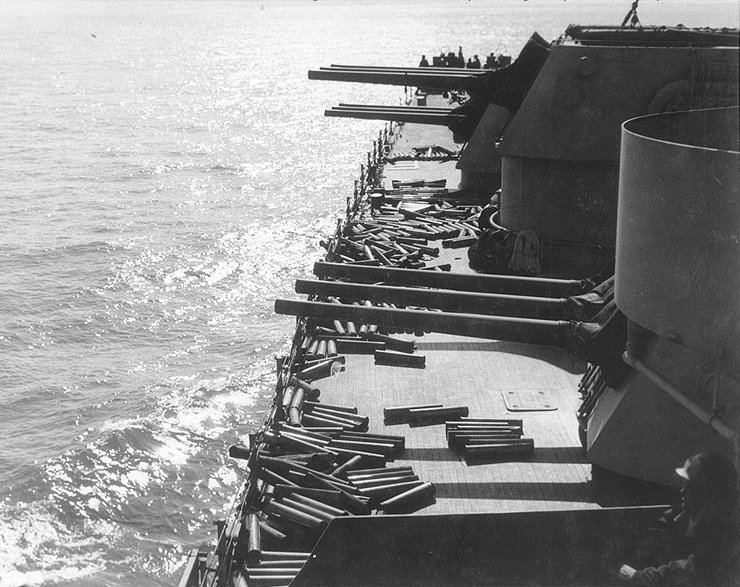
In 1942 as completed, the first Cleveland class cruisers were armed with four triple 6″/47 caliber Mark 16 guns, six dual 5″/38 caliber guns, and four triple 28 mm AA. TTs were also eliminated that this stage. However they were soon rearmed, after sea trials or the first refit, by two quad Bofors 40 mm guns and two dual ones, plus up to twenty single Oerlikon 20 mm cannons. Compared to the Brooklyns, they lost a main turrets but gained much better secondary guns as well as much better FCS (formerly 5″/25 caliber guns, and four dual 5″/38 caliber guns on St. Louis and Helena). At the end of the war, from USS Vicksburg (CL-86, June 1944) this was increased to four quad Bofors 40 mm guns and six dual Bofors 40 mm guns, while the lighter Oerlikon 20 mm cannons were halved. On USS Fargo and Huntington, the completely reworked superstructure allowed an increase of the arc of fire for all secondaries and Bofors, and perhaps sixteen 20 mm guns.
6-in Mark 16 guns
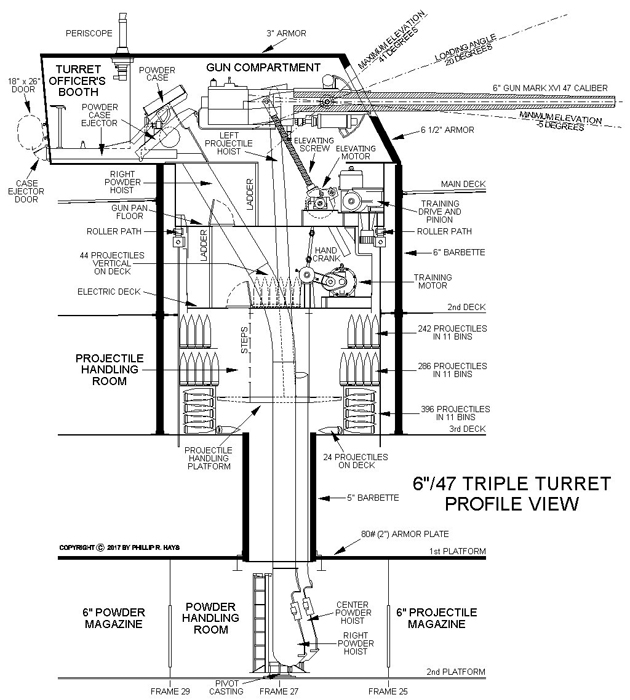
These guns were common to the Brooklyn and Cleveland class, Developed from earlier experiments with old 6″/50 (15.2 cm) Mark 8 guns. The new design incorporated a separate, semi-fixed ammunition while it was tailored to fire tne new “super heavy” AP 6-in shell which had almost double the penetration performance compared to the old Omaha class. The barrels were monobloc autofretted, with their liner secured to the housing, by a bayonet joint. Mod 1 had a tapered liner. They also used a semi-automatic vertical sliding breech block with a 0.5 in ring attachment at the muzzle. Performances with the “super heavy” AP Mark 35 Mods 11 was 26,118 yards (23,881 m) at 47 degrees, as the elevation was ported to 60°. Accuracy was so poor beyond 47° the guns were only used for coastal shelling. The barrel life was between 750 and 1,050 rounds, but each gun was “only” provided with 800 rounds. Their high rate of fire proved a blssing in ship to ship engagements. These guns also fire the HC Mark 34 Mods 1-7 and Illumination rounds Mark 32 and 38 for night battle.
5-in/38 Mark 32 guns
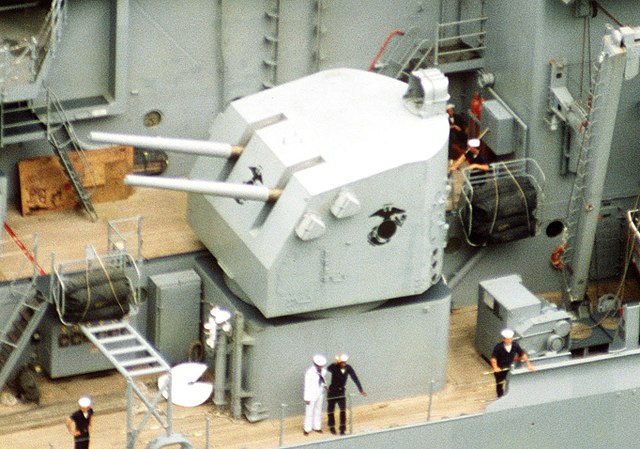
The unquestionably finest Dual Purpose gun of World War II, there in six twin turrets with independent cradles. The were hand-loaded but power-rammed, which procured high rate of fire and with loading at any angle. The shell became proximity-fuzed AA from 1943, with a much greater efficience.
AA guns
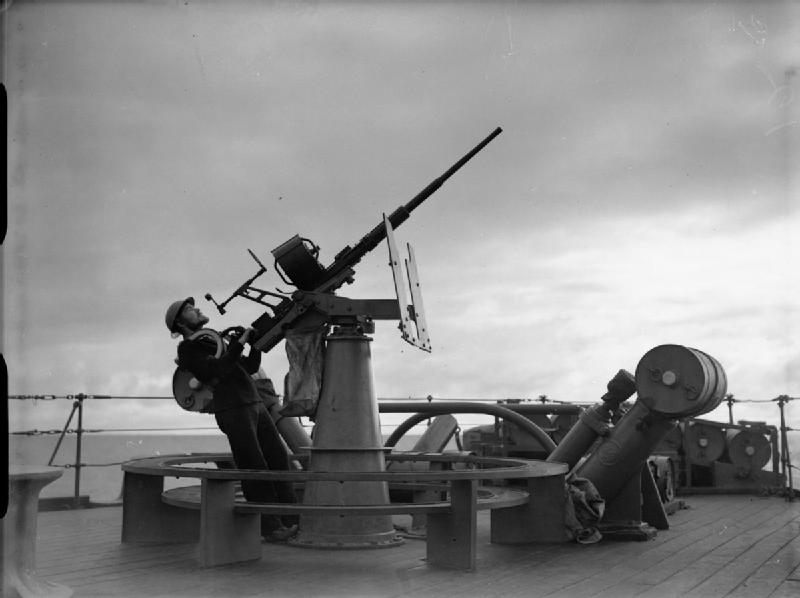
-Initially five quad 1.1 in AA guns (28 mm).
-In 1941 BuOrd (The burea of Ordnance) wanted to replace all of these quad 1.1 inch guns with the new licence-built 40 mm Bofors, in dual mounts since they weighed about the same. However the decision was overruled by the admiralty, ordering to replace them with quad mounts for increased firepower. Thos only added to the misery of these top-weight vessels and was only combated by an increase of much lighter Oerlikons.
Note: The 1.1, Bofors 40mm and Oerlikon 20mm will be seen in the tech section.
Fire control systems

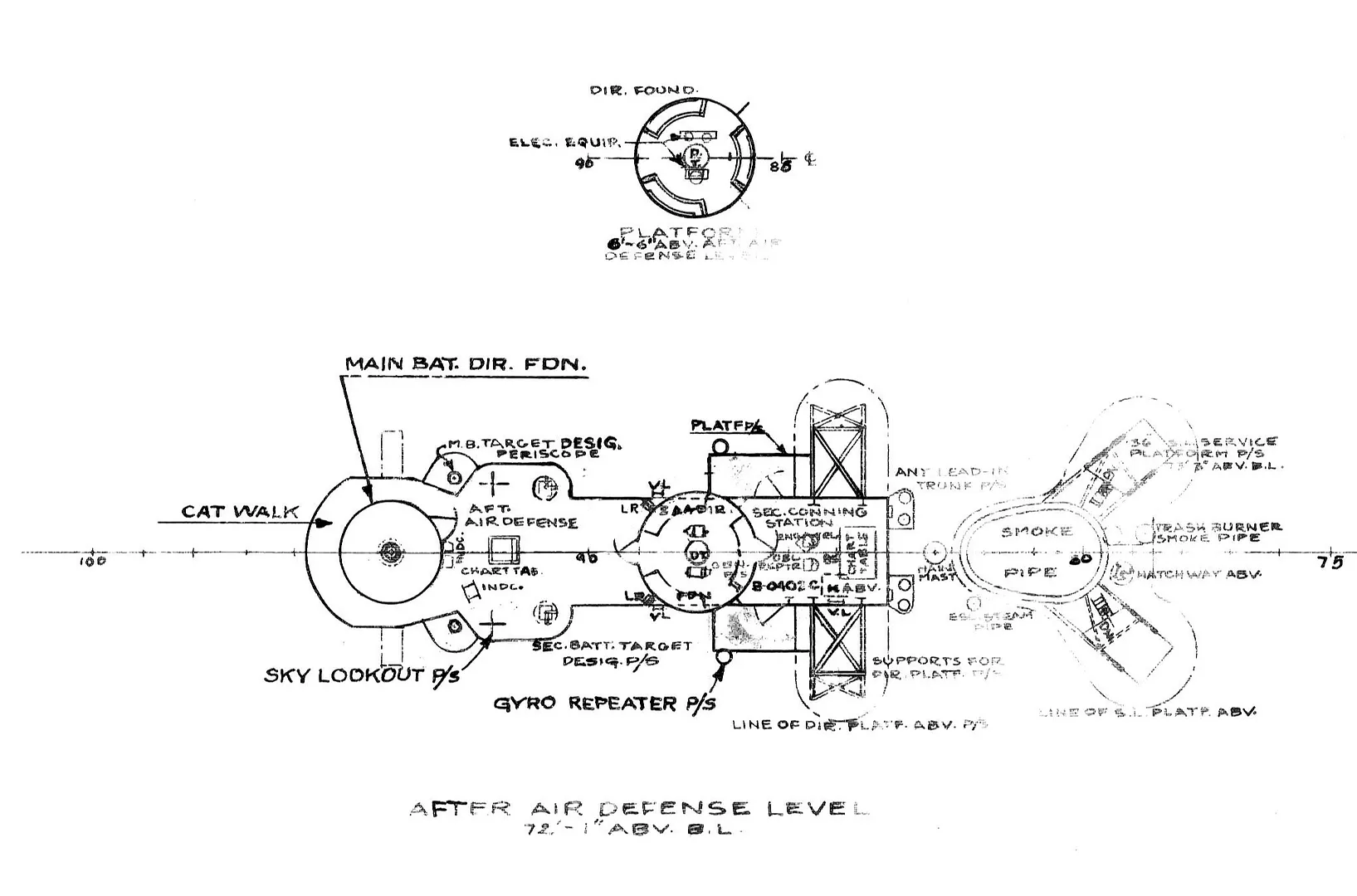
Technical schemes of the superstructure and FCS
The Cleveland’s forward primary director was also the ship’s primary spotting station, usually under the direct personal command of the ship’s leading spotter. The Cruisers of the Cleveland and Fargo class, just as the Brooklyn class were goiven the ubiquitous Gun Director Mark 34. It mounted a Rangefinder Mark 45.
The was a main-battery plotting room located below the waterline, inside the armor belt, and containing the rangekeepers and associated graphic plotters. These were Rangekeeper Mark 8, setup for the 6”/47 caliber. They had also stable-vertical gun directors Mark 41, linked to radar equipment (Mark 27, while the control consoles and indicators were setup for the Radar Equipment Mark 13., and a fire-control switchboard plus its associated battle-telephone switchboard. All cruisers had a unique single main-battery plotting room, with a single rangekeeper and stable vertical set Mark 6 used with the auxiliary computer. For divided fire, auxiliary equipment and procedures were used which changed on the larger Salem and Worcester class cruisers, fitted with duplicate rangekeepers and stable verticals.
Radars
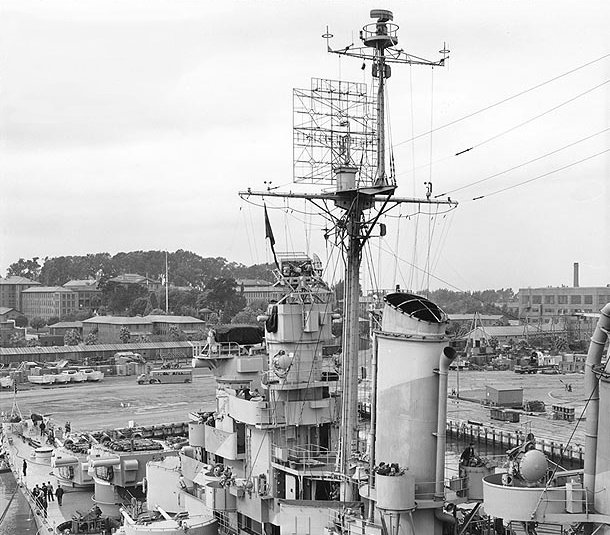
Note that the Cleveland class arrived at a time radar for cruisers became mandatory: They were all provided with the SK-1 air-search radar, or for the latter series, the SK-2 air-search radar, the SG-6 surface-search radar
and SP fighter-direction radar. Cold war vessels were given the upgraded the AN/SPS-6 air-search radar and SR-3 air-search radar. The SK-1 was only able to track large surface ships. Developed from the SC-2, with a CXAM antenna and optional IFF Bl-5 antenna atop the main antenna. It had a 1.5 m wavelenght, a pulse width of 5 microsecond, a pulse Repetition Frequency of 60 Hz, a scan rate of 4.5 rotations per minute.
Its power unit was only 200 kW at the time, ensuring a practical rannge of 100 nautical miles (190 km) to spot bombers, 75 for fighters, 30 nm a surfaced battleship (so 55 km, well beyond gunnery range) and 13 nautical miles (24 km) only for a destroyer. For a cruiser it was probably around 40 km (21 nm). The Antenna was shaped as 17 feet square 6×6 dipole “mattress” array. As an early long-wavelength seaborne radar, it had a tendency to reflect off the sea surface and produce self-interference (Lloyd’s mirror effect) at certain altitudes. Maintaining contact with an approaching spot was difficult. This proved a significant liability during the kamikaze campaign. Many cruisers received in addition microwave radars, less subject to nulls but missing the altitude and range.
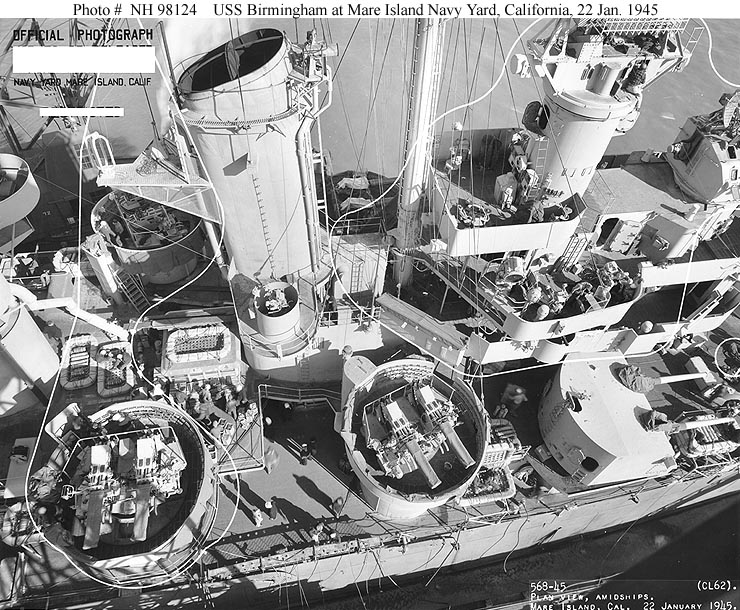
Details in USS Birmingham
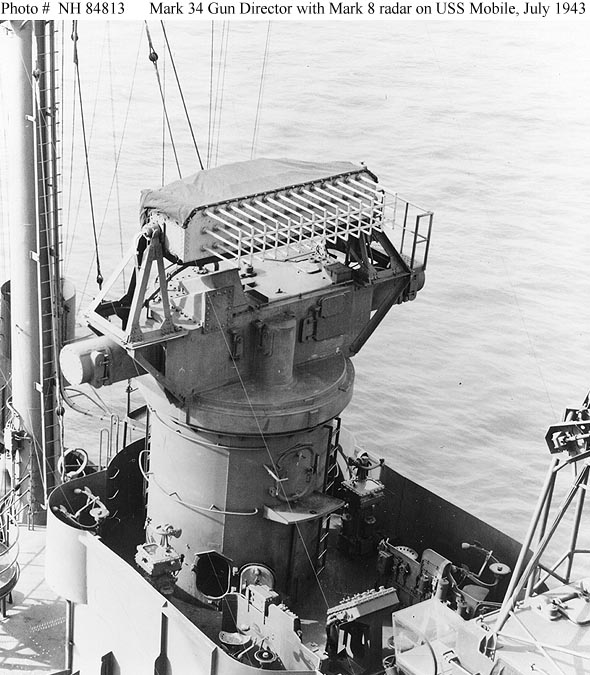
Mark 34 Director
AA directors
On board aviation
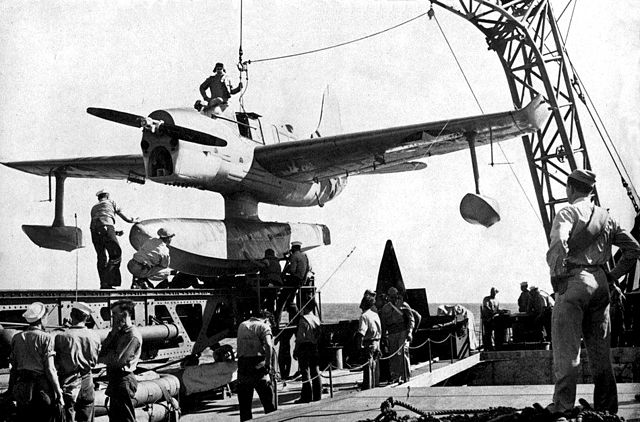
Curtis SO3C Seamew on the catapult USS Columbia, 1943
It was the best of worlds with the shape of the stern on these cruisers, able to carry two catapults and four seaplanes with a large hangar and workshop, plently of space for aviation gasoline tanks, oil, armament including depht charges and bombs. These cruisers were able to launch two planes in quick succession for reconnaissance and spotting, while the lift brough the two others, quickly lifted on the reloaded catapults for a rapid second launch. It is generally agreed the Cleveland class when they were commissioned were provided with the latest and best general purpose seaplane available, the Vought OS2U Kingfisher (ex. USS Mobile 1944). However, photos shows some carrying the Curtiss SOC seagull (ex. on Cleveland in 1944) when available to replace the mediocre Curtiss Seamew, often present of the photos. In 1945, the latter shows Curtiss SC Seahawk mandatory on board. They were still used during the Korean war.
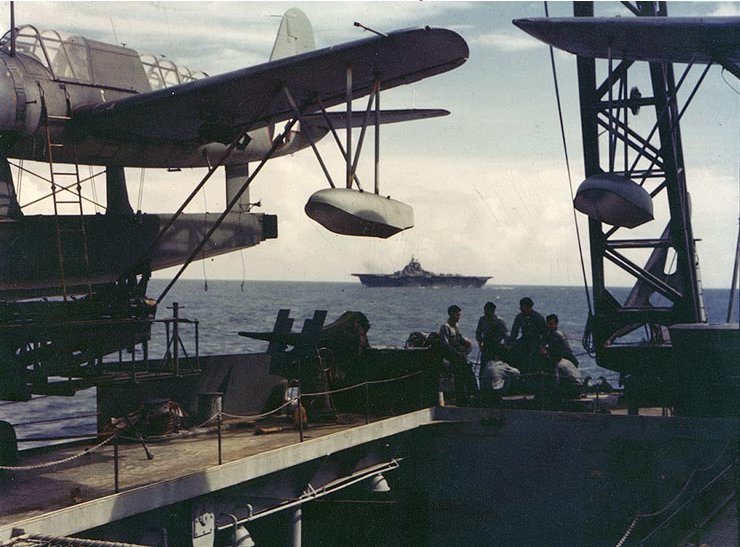
Kingfisher onboard USS Mobile, 1944.
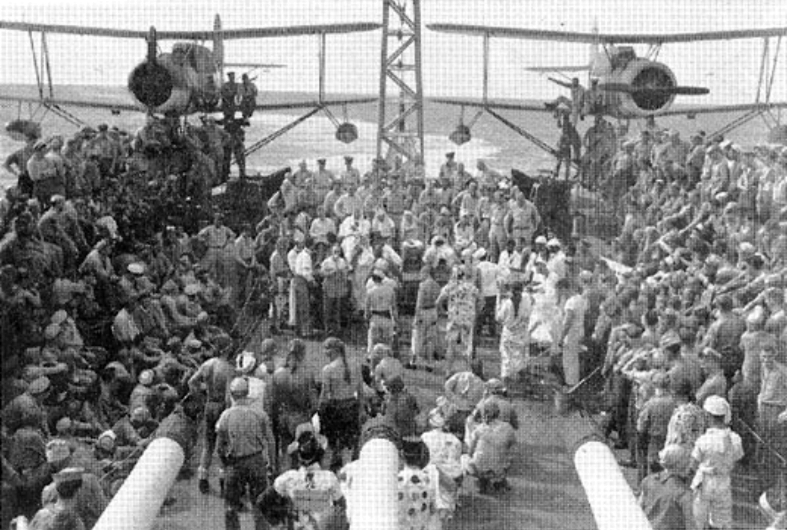
Crossing the line ceremony onboard USS Montpelier, Curtiss Seagull.
USS Cleveland specifications |
|
| Dimensions | 185.9 m long, 20.22 m wide, 7.47 m draft |
| Displacement | 11,744 t. standard -14 130 t. Full Load |
| Propulsion | 4 shafts GE turbines, 4 Babcock & Wilcox boilers, 100,000 hp. |
| Speed | 32.5 knots (60.2 km/h; 37.4 mph) |
| Range | 10,000 nmi (19,000 km; 12,000 mi) at 15 knots (28 km/h; 17 mph) |
| Armament | 5×3 6 in (152 mm)/47,6×2 5 in (127 mm)/25, 28x 40mm, 10x 20mm, 4 floatplanes |
| Armor | Belt 127, turrets 165, bridges 51, inner casemate 127-152 mm. |
| Crew | 1273 |
Profile Illustration of the Cleveland class

USS Cleveland 1943
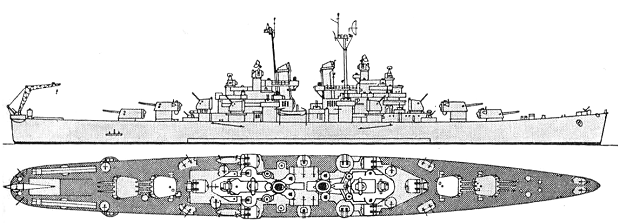
USS Vincennes 1963, the last ‘conventional-state’ Cleveland class cruiser in service
A late solution: The Fargo class (1942)
Fargo, Huntingtonn, Newark, New Haven, Buffalo, Wilmington, Vallejo, Helena, Roanoke, unnamed, Tallahassee, Cheyenne, Chattanooga (CL-106 – CL-118)
USS Fargo (CL-106) was the lead ship of a sub-class of light cruisers evolved from the Cleveland serie, but most of this class was canceled due to the end of the war. The Fargo-class cruisers were a modified version dsigned by BuOrd in 1943-44 to solve several issues with the design, notably stability, by reducing top weight, and granting a better arc of fire and more Bofors 40 mm AA positions. This was achieved by a far more compact pyramidal superstructure, and single trunked funnel. Well centered, this island free most if the allocated superstructure surface for more AA while still keeping the overall displacement in check, and the metacentric height at an acceptable level. The main battery turrets were placed just a foot lower, the wing 5 inch twin gunhouses were also lowered to the main deck. The 40 mm AA mounts were lowered when possible, helped by the new compact superstructure.
Due to the design time, and approval, it was not ported on an exiting ship, USS Fargo, before the latter was launched 25 February 1945, at New York Shipbuilding Corp. New Jersey. The new cruiser, pennant CL-106, was sponsored by Mrs. F. O. Olsen. She was commissioned on 9 December 1945 with Captain Wyatt Craig in command, but of course at that point, the war was over and her main purpose, intended to deal with kamikaze, no longer relevant. Many of her design peculiarities however went to the next Worcester class. In all, 13 ships were planned.
The war ended when all these were laid down and in construction, the last being USS Wilmington (CL-111, on 5 March 1945). Only Fargo and Huntington were ever completed, the rest being cancelled, even before the end of the war, in what was called de-escalation. USS Newark was in fact the last launched, on 14 December 1945, but not commissioned. Construction was indeed canceled on 12 August 1945, 67.8% completed. She was repurposed to be used in underwater explosion tests. After those were performed, she was mothballed, then sold on 2 April 1949 for scrapping.
USS Fargo herself commissioned on 9 December 1945, four months after the war ended found limited use, and even more Huntington, commissioned early in 1946. They were perhaps the shortest-lived cruisers in USN service, as both cruisers were decommissioned in 1949–1950, after some training and gunnery exercises to evaluate their concept. But after being mothballed and placed in reserve, they were never reactivated. For USS New Haven (CL-109), launched on 28 February 1944, USS Buffalo (CL-110) on 2 April 1944, and USS Wilmington on 5 March 1945 (CL-111), construction was cancelled on 12 August 1945, at various degrees of completion (from 20 to 50%) and they were all scrapped on slip. This situation was also applied to USS Vallejo, Helena, Roanoke and an unnamed fourth vessels, all ordered, but not laid down, and cancelled 5 October 1944. The last of the Cleveland serie, USS Tallahassee (CL-116), laid down 31 Jan. 1944, USS Cheyenne (CL-117) on 29 May 1944, plus USS Chattanooga (ex-Norfolk) on 9 October 1944, Construction was cancelled on 12 August 1945 and they were scrapped on slip as well.
The same type of modification was applied to heavy cruiser as well, between the Baltimore and Oregon City sub-class. It was also applied, but to a lesser degree, to the Atlanta class, compared to the Juneau class AA cruisers. But changes to reduce instability was particularly urgent and important for the Cleveland-class, notably to deal with dangerous roll.

Design S-511-38 6″ A.A. Cruiser Scheme A, 31 July 1941. This was a 4 Triple Turrets Preliminary design plan prepared for the General Board. A further developent of the Cleveland, as a light cruiser with rapid-firing dual purpose 6-in/47 anti-aircraft guns in triple turret version. The latter development was never completed; so the design evolved in 1943 with five twin turret instead, and ultimately became the Worcester (CL-144) class. 664-foot waterline ship, 14,000 standard tons, emphasizing speed and main battery number with reduced protective armor. Naval History and Heritage Command., U.S. Naval History and Heritage Command Photograph coll.
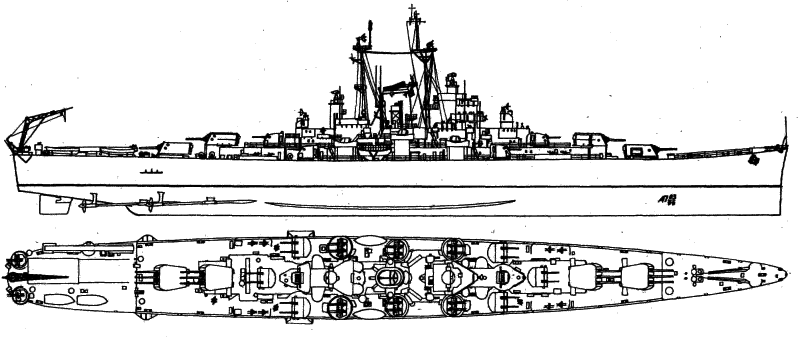
USS Fargo specifications |
|
| Dimensions | 185.3 m long, 20.22 m wide, 6.60 m draft |
| Displacement | 11,500 t. standard -14 460 t. Full Load |
| Propulsion | Same as Cleveland |
| Speed | Same as Cleveland |
| Range | Same as Cleveland |
| Armament | Same but 4×4 + 6×2 40 mm, 20x 20mm AA |
| Armor | Turrets 5-in, bulkheads 5-in. |
| Sensors | SK-2, SR-3 air-search radars, SG-6 surface-search radar, SP fighter-direction radar |
| Crew | 1,100 |
Torpedo and battle damage on Cleveland class vessels
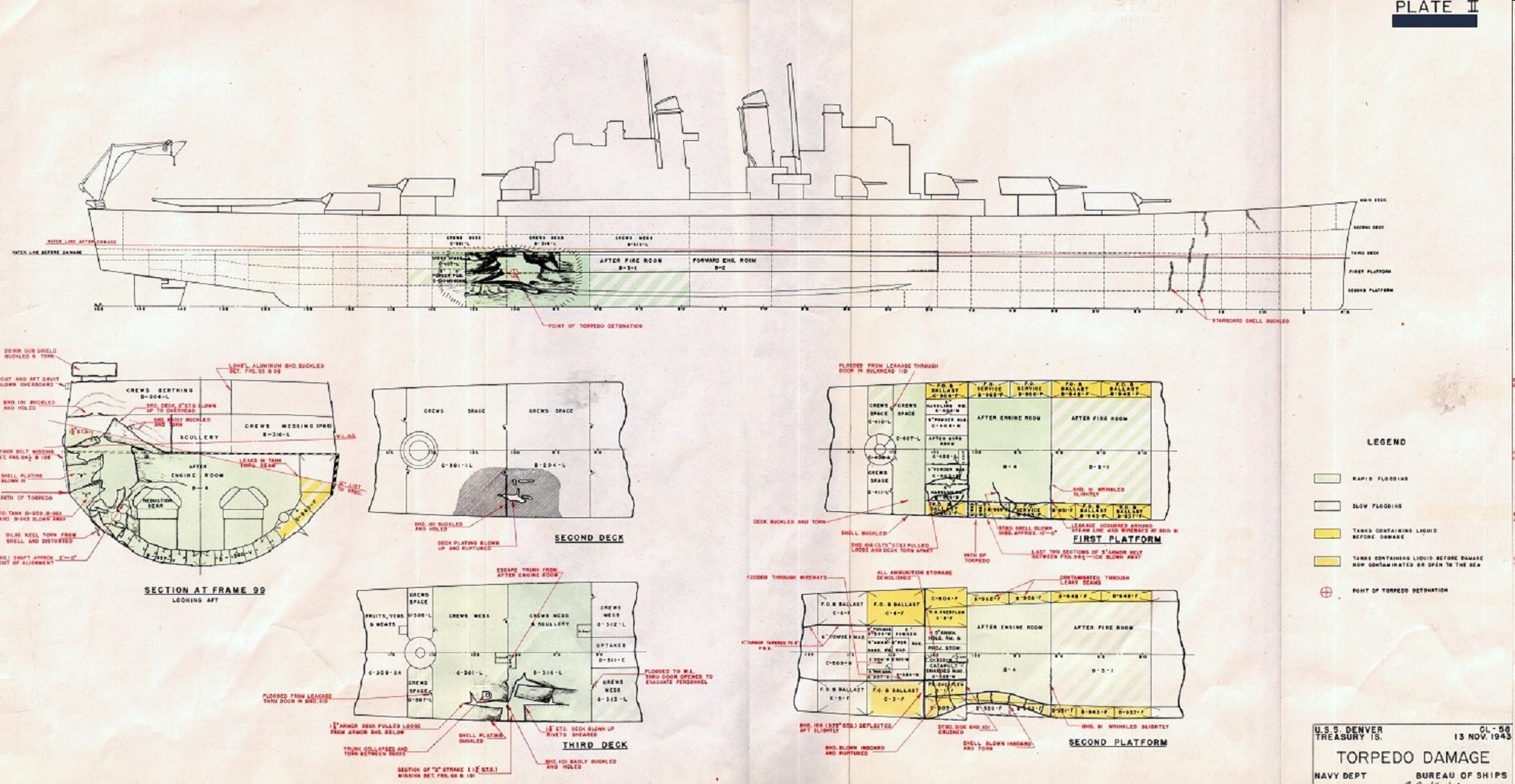
USS denver torpedo damage report
_Battle_of_Kula_Gulf_6_July_1943.jpg)
USS Helena Kula gulf report 6 July 1943
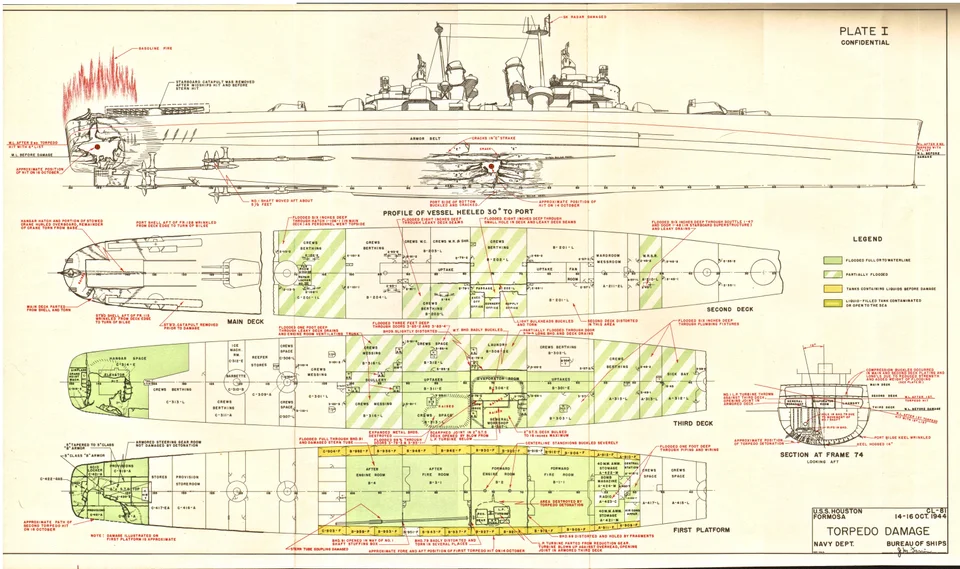
USS Houston torpedo damage report (The most serious case)
USS Houston was the only of the class very close to sinking, torpedoes by two aerial models, the other one being the USS Birmingham when closing for assistance to the crippled and burning USS Princeton. As for the CVs of the USN, the damage control parties did wonders each time.
Late Summer 1941 unbuilt CV conversion
Before the Independence class (CVL) standard conversion (approved in June 1942), other schemes were studied:
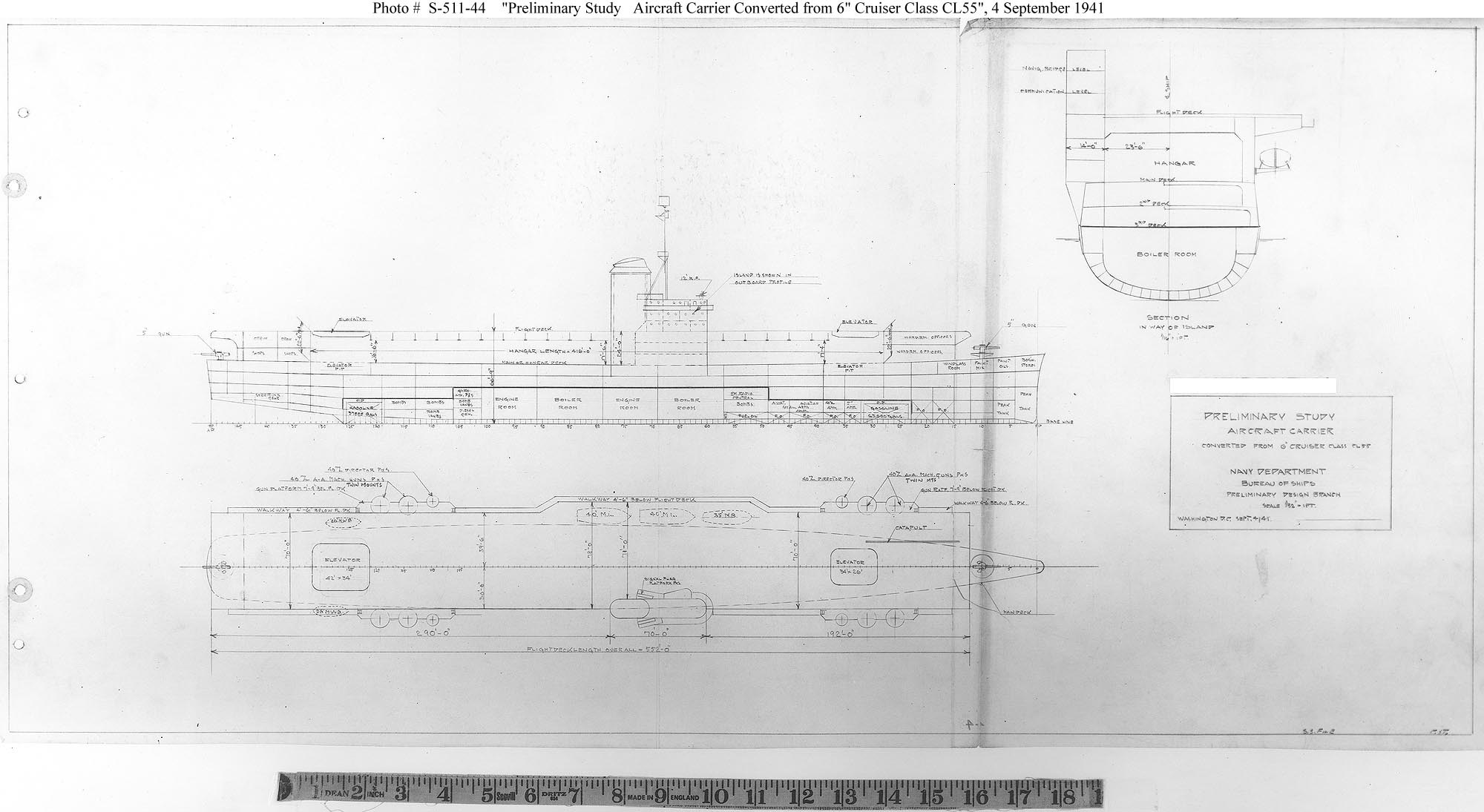
This conversion design project S511-43 dated back from August 1941. It was caracterized by a much larger island on starboard compared to the one fitted on the CVLs for stability reasons, and integrated a mast, two main AA directors, a single funnel and large staged island with the first two quad Bofors grouped fore and aft (as the Essex class) and the remainder two on the port side. Unlike the Independance class, there was an add-on overhang also on this side to allow more plane deck parking and the flight deck seems a bit wider as well.

This S511-44 prelimary study dated back 4 September 1941. It showed a slightly taller hangar but overall a comprehensive island, joint to the exhausts truncated into a single funnel. It had a large aft elevator, two 5-in guns and eight quad 40 mm Bofors (32 total) plus their four attached directors in independent sponsons, but no secondary AA artillery.
USS Fargo (CL-106)
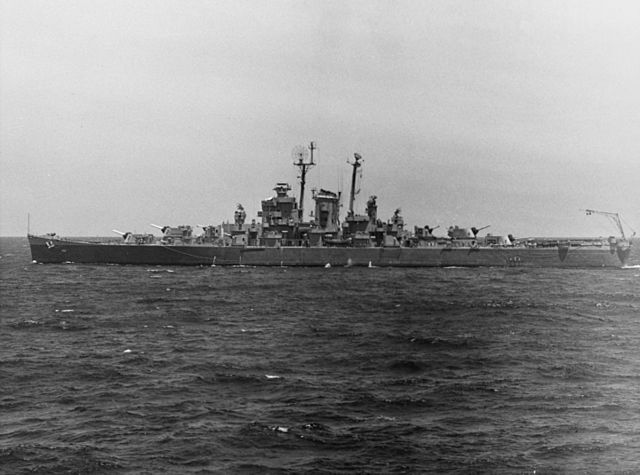
Fargo departed Philadelphia, where she was completed, on 15 April 1946 under orders of Vice Admiral Bernard H. Bieri, on board for a goodwill cruise to Bermuda, Trinidad, Recife, Rio de Janeiro and Montevideo. On 31 May 1946, tshe sailed for the Mediterranean, visiting Turkey, Lebanon, Greece, Italy, France, North Africa. She was stationed as an American representative at Trieste during the crisis between Italy and Yugoslavia.
She was back to New York City on 2 March 1947 but mad another cruise in the Mediterranean on 20 May 1947 being during one month, flagship for the Commander of Med. Naval Forces. She was back to Newport on 13 September but the crew and the ship were prepared for extensive Atlantic Fleet exercises. They started in October and were completed in November 1947, from Bermuda to Newfoundland.
She hosted Vice Admiral Arthur W. Radford (2nd Task Fleet Commander). In 1948, she made another tour of the Mediterranean and another large scale exercises in the Caribbean. The routine went on in 1949 as well. After these active years were her machinery was well tested, she was eventually decommissioned, placed in extensive reserve.
She was affected to the Bayonne (New Jersey) long-term berth on 14 February 1950. During the Korean and Vietnam she stayed in reserve, until she was stricken from the Naval Register on 1 March 1970 and sold for BU, on 18 August 1971. She was broken up by the Union Minerals and Alloys Corporation in Kearney (New Jersey).
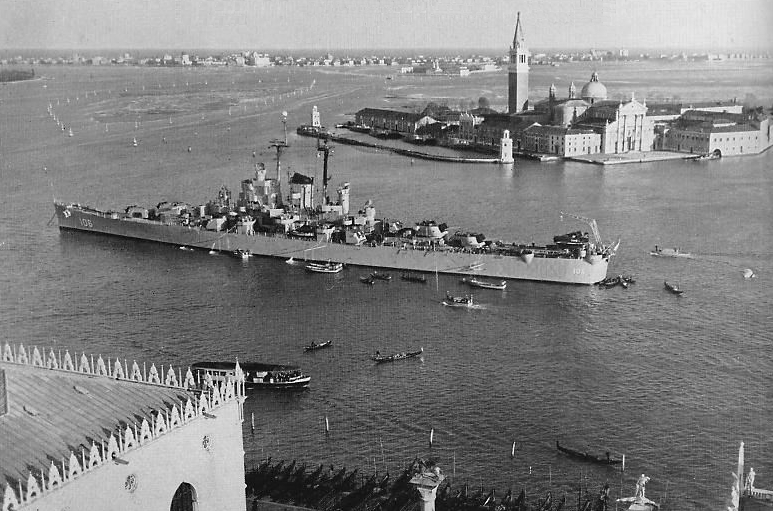
USS Huntington (CL-107)
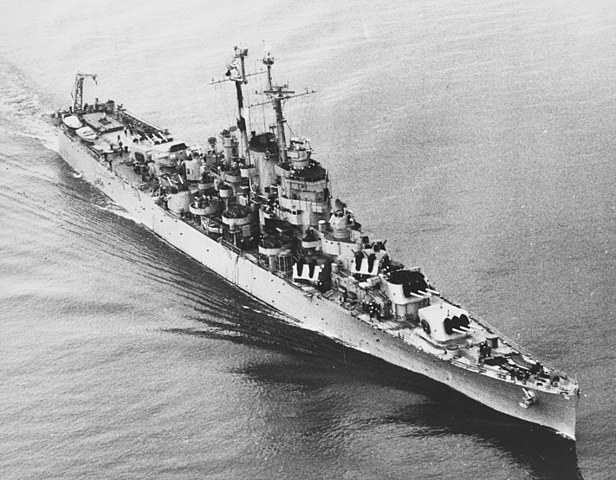
USS Huntingon was commissioned on 23 February 1946 under command of Captain Donald Rex Tallman. She made her sea trials, followed by a shakedown cruise off Guantánamo Bay (Cuba) until back to Philadelphia for post-trials fixes. On 23 July 1946 she sailed for her first mission, joining the 6th Fleet in the Mediterranean. Like her sister ships, she visited many ports like Naples, Malta, Villefranche, and Alexandria. Her presence was needed amidst regional tensions duen to communism insurgency in Greece, troubles in Turkey and in the Balkans or in palestine. In this volatile situation she reassured the US allied. She departed Gibraltar on 8 February 1947, to join exercises off Guantánamo Bay. She was back in Norfolk and later Newport and Rhode Island, departing on 20 May 1947 for another tour in the Mediterranean.
Back on 13 September 1947, Huntington departed Philadelphia on 24 October, carrying the Naval Reserve for exercises off Bermuda, and up to Newfoundland. This was over on 14 November 1947. She was refitted extensively afterwards in Philadelphia, her overhaul lasting until 12 April 1948.
Captain Arleigh Burke (yes, that one), assumed command in between December 1947 and December 1948. She departed Norfolk in April from a refresher training cruise, stopped in Newport and made another tour in the Mediterranean, starting on 1st June 1948. She visited mny ports until August 1948 and crossed the Suez Canal on 22 September 1948 for another good will tour of East Africa, then west Africa via the Cape of good hope, and South America. She visited Buenos Aires in November, greetng her guest President Juan Perón. She sailed to Uruguay and received there another visit from President Luis Berres, on 10 November. She stopped again at Rio de Janeiro and Trinidad, then headed home, arriving on 8 December 1948.
In January she made another cruise from Philadelphia to the Caribbean and back to Newport. From 22 January she stayed idle, until decommissioned on 15 June 1949. She was placed in extensive reserve, she lasted until she was struck from the List on 1 September 1961. She was sold for BU at Boston Metals (Baltimore) on 16 May 1962.
Cold War Clevelands (1950-1979)
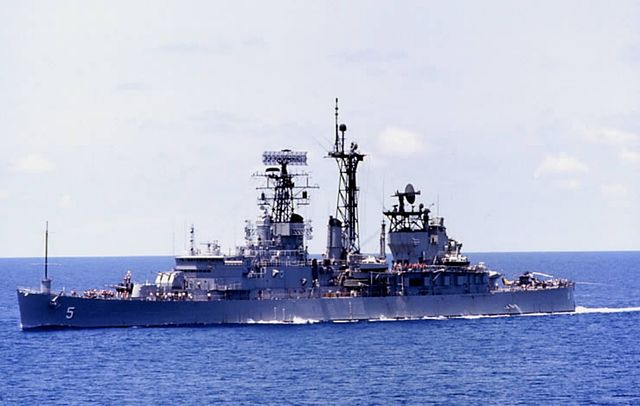
CGL-5 USS Oklahoma City in 1974
Apart the ten Independence class fast CVs which a few soldiered under other flags longer than their USN counterparts (like the Spanish Dedalo), the fifteen Cleveland class cruisers were decommissioned in 1949-50 amidst postwar long-term reserve program. With the Korean war, some were reactivated and participated to various missions, and went to various periods of semi-reserve. Apart radars upgrade in the 1950s, the conventional ships kept “in stock” condition were discarded in 1960. Other were converted with the CG, CAG and CLG modernization program as missile cruisers or for other uses. A single one was preserved: USS Little Rock. The others were decommissioned in the 1970s.
The CGL fleet escort conversions were the most interesting, but they will be seen as a standalone post. These cruisers had their entire aft section, after the second funnel, completely rebuilt in 1955-58 or 1956-60, with a stage structure for FCS, entirely dedicated to carry and operate the Talos long range SAM and Terrier medium range SAM on the early and later serie. In all, six ships were so converted with many differences in design. CG3-5 (USS Galverston, Little Rock, Oklahoma City) were Talos escorts, while CG6-8 (USS Providence, Springfield, Topeka). Two were discarded in 1973, one in 1976 two in 1979 and one preserved. More more information about these, see cold war USN missile cruisers. Their larger Baltimore class heavy cruiser wartime cousins benefited from more ambitious conversion programs allowing them so serve until the 1980s.
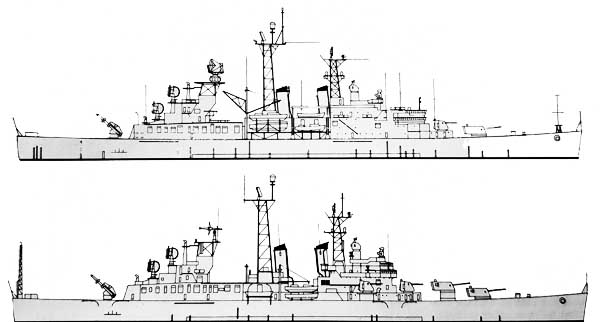
Compared profiles of the two conversions, CG and CGL.
While the Cleveland-class cruisers served mainly in the Pacific and especially with the Fast Carrier Task Force (with Cleveland-based Independence class CVLs) some also served in Europe and Africa with the U.S. Atlantic Fleet durung late 1942-late 1944 operations until the Mediterranean became an “allied lake” and the North Alantic mostly secured. A cruiser was less helpful against u-Boats and the bulk of the surface Kriegsmarine was gone by late 1944. All of these warships worked heavily, winning many battle stars, awards, and survived the war. They were initially decommissioned by 1950 except USS Manchester, soldiering until 1956. None saw action in the Korean War but the latter, and none of the “long reserve” was recommissioned as they required a crew almost as large as the Baltimore-class cruiser, which were reactivated instead due to their longer range artillery and better caracteristics overall. The non-converted ships were eventually sold off, directly from from the reserve fleet to scrap, from 1959. Six were however taken to bolster the surface fleet missile carriers and converted into guided missile cruisers, reactivated during the late 1950s. They served into the 1970s, 1979 for the last one but the Talos-armed ships suffered from even greater stability problems than the original, becoming so severe in fact USS Galveston was prematurely decommissioned in 1970, not worth the cost of her reconstruction. USS Oklahoma City and Little Rock were given a large amount of ballast, internal rearrangement allowing them after an overhault to remain active until 1979, December, for Oklahoma City.
Profiles

USS Birmingham in 1944, soon after the battle of Leyte where she was badly damaged by the explosion of the carrier St Lo (to be redone)
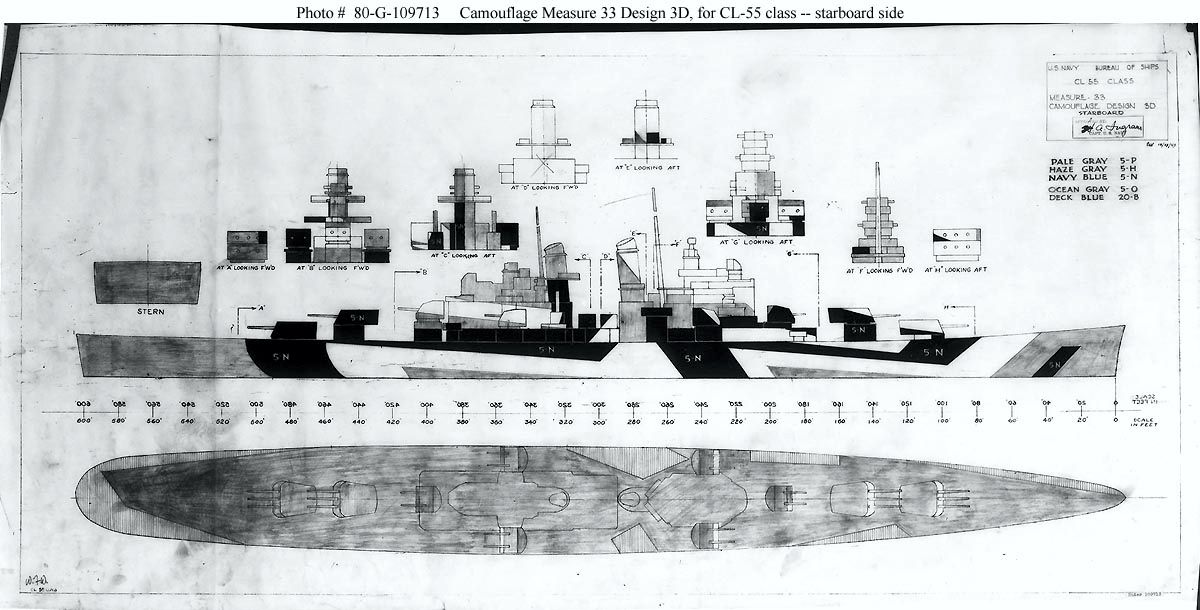
ONI Camouflage Measure 33, USS Cleveland 1944.
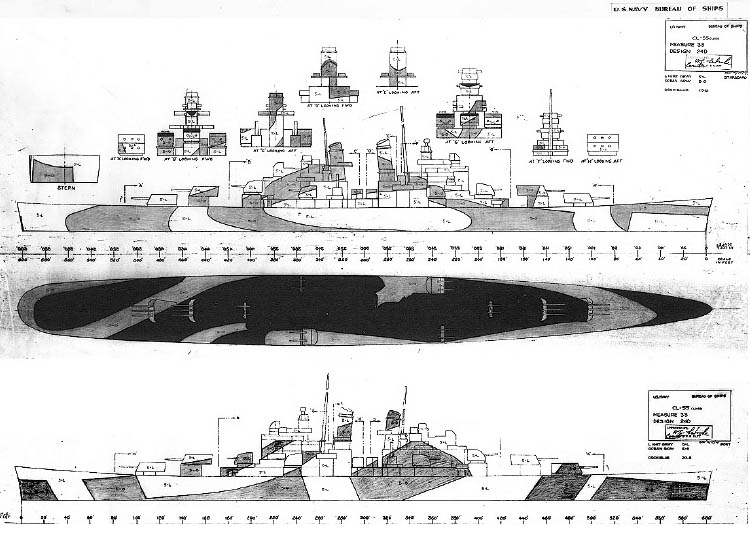
Measure 33 design 40, 1944.
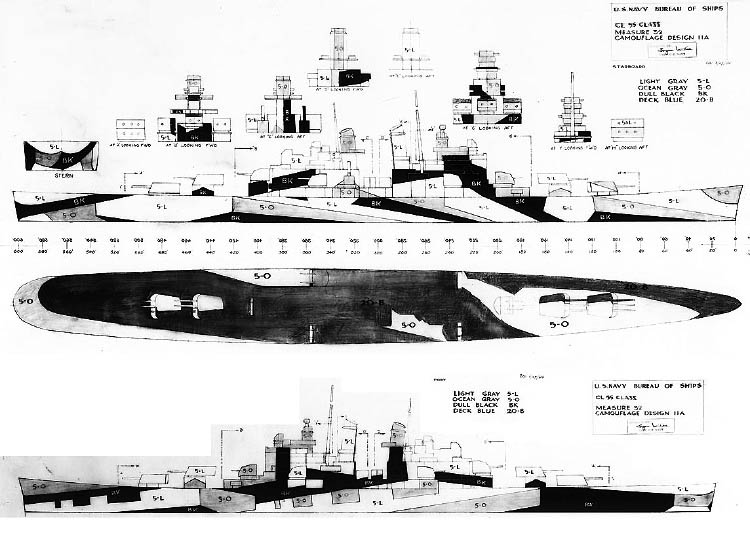
Measure 39 design 11
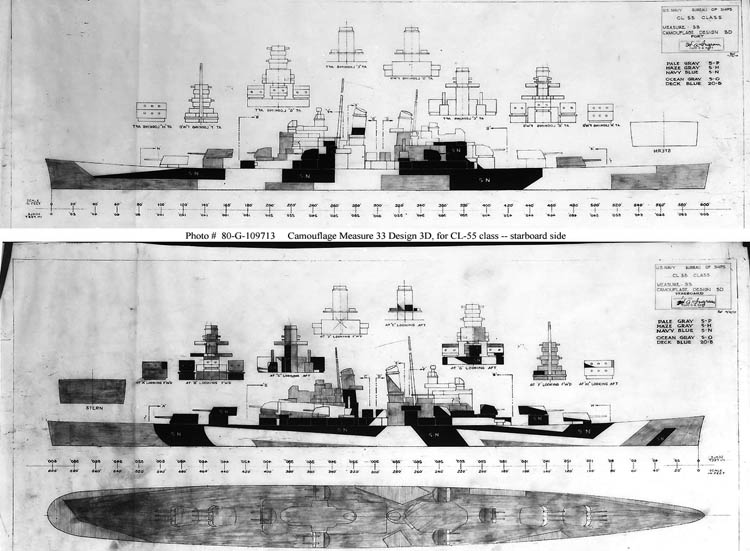
Measure 33 design 3d.
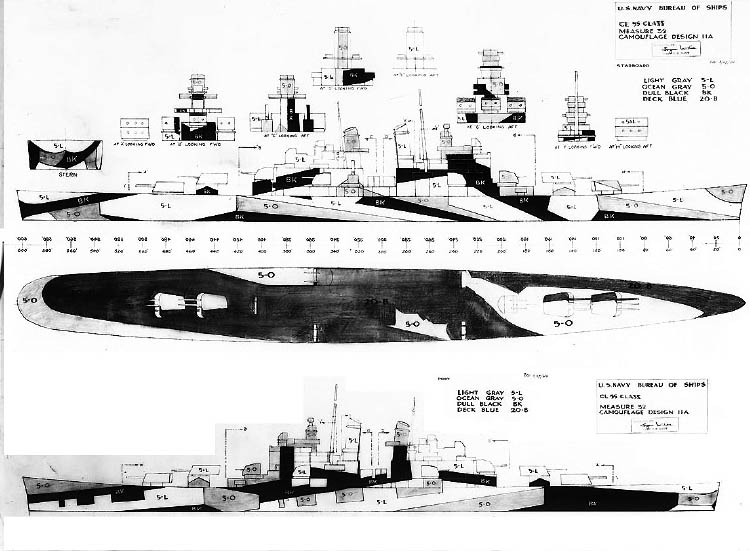
Measure 32 design 11a.
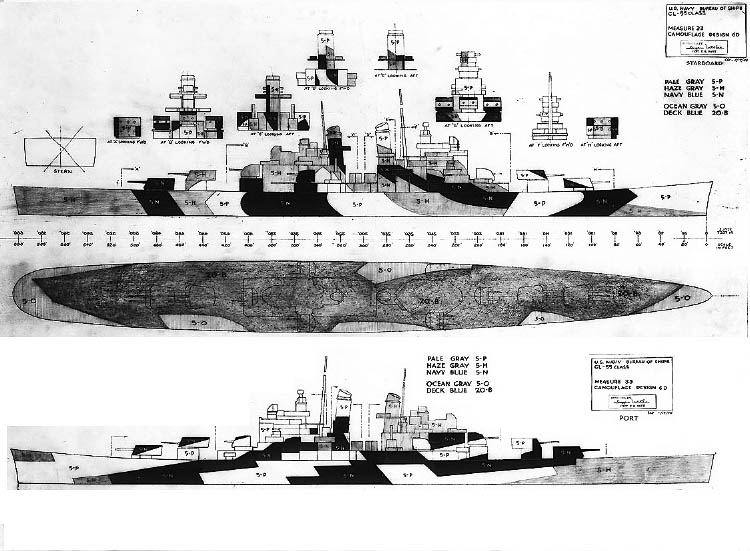
Measure 32 design 4d.

USS Cleveland, CL-55 in trials off Chesapeake, May 1942, measure 3 light ocean gray

USS Cleveland in Operation Torch, November 1942 measure 12 modified
(More to come)
Sources
Links
https://www.okieboat.com/Cleveland%20Class%20History.html
http://www.navweaps.com/Weapons/WNUS_5-38_mk12.php
http://www.navsource.org/archives/01/57x.htm
https://www.ibiblio.org/hyperwar/USN/Admin-Hist/USN-Admin/index.html
http://www.historyofwar.org/articles/weapons_cleveland_class_cruisers.html
https://www.okieboat.com/Cleveland%20Class%20History.html
https://www.history.navy.mil/our-collections/photography/numerical-list-of-images/nhhc-series/s-file/S-511-18.html
http://www.ibiblio.org/hyperwar/OnlineLibrary/photos/images/s-file/
http://pwencycl.kgbudge.com/S/k/SK2_air_search_radar.htm
http://www.navsource.org/archives/04/107/04107.htm
https://www.history.navy.mil/research/histories/ship-histories/danfs/h/huntington-ii.html
https://www.okieboat.com/Gun%20Director.html
https://www.globalsecurity.org/military/systems/ship/cl-55.htm
http://www.hazegray.org/navhist/cruisers/ca-cl2.htm
http://www.historyofwar.org/articles/weapons_cleveland_class_cruisers.html
http://www.microworks.net/pacific/ships/cruisers/cleveland.htm
https://web.archive.org/web/20150406062952/http://buffalonavalpark.org/exhibits/ships/
Books
J. Gardiner Conway’s all the world’s fighting ships 1922-1947
Wright, C. C. (1998). “Question 51/96: Anti-Aircraft Armament of US Cleveland Class Cruisers”.
Norman Friedman, U.S. Cruisers, An Illustrated Design History
Naval Anti-Aircraft Guns and Gunnery loc 3772 – 3792
M. J. Whitley, Cruisers Of World War Two, An International Encyclopedia 1995
Those Cleveland Class Cruisers. An exercise inexpediency in N.Wilder Post.’ Sea Classics
Buffalo & Erie County Naval & Military Park.
Eye candy 3D
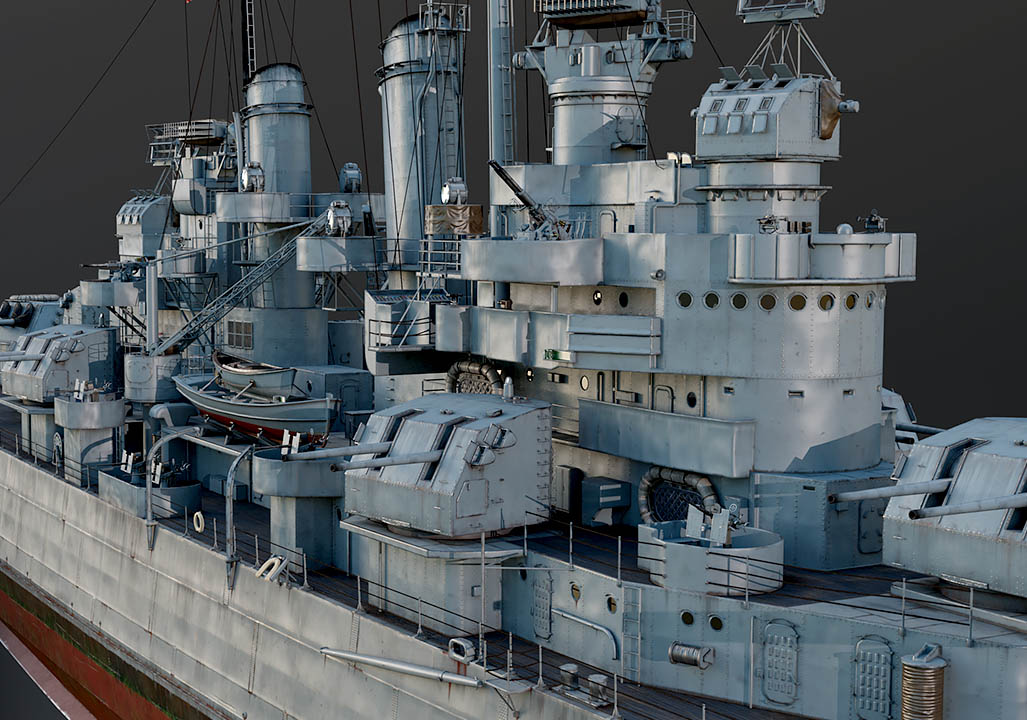
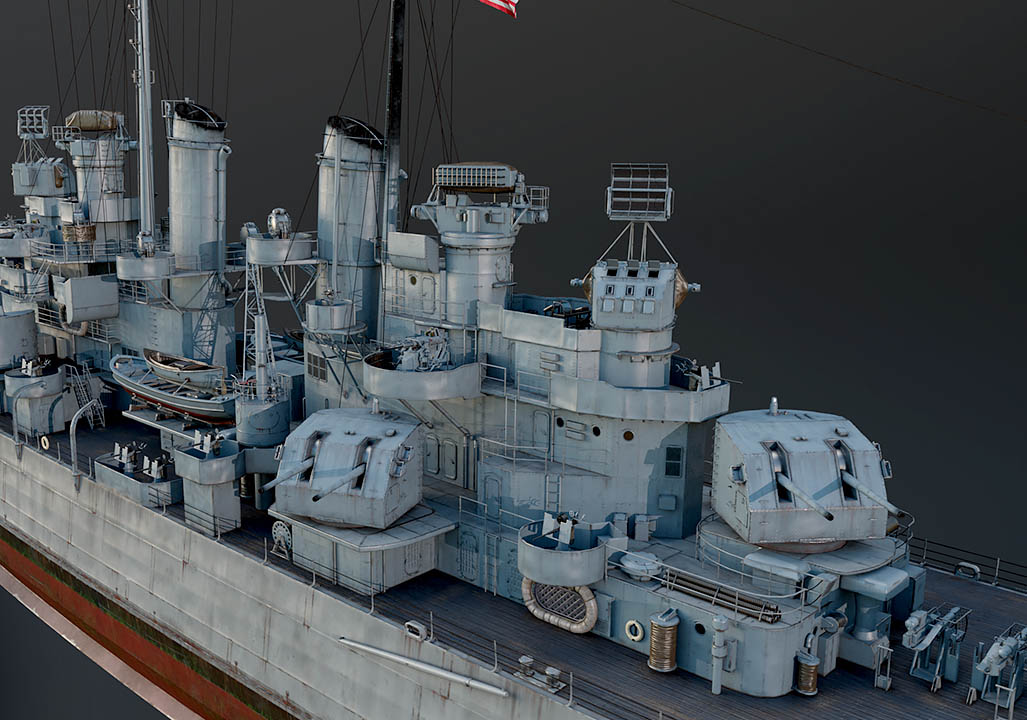
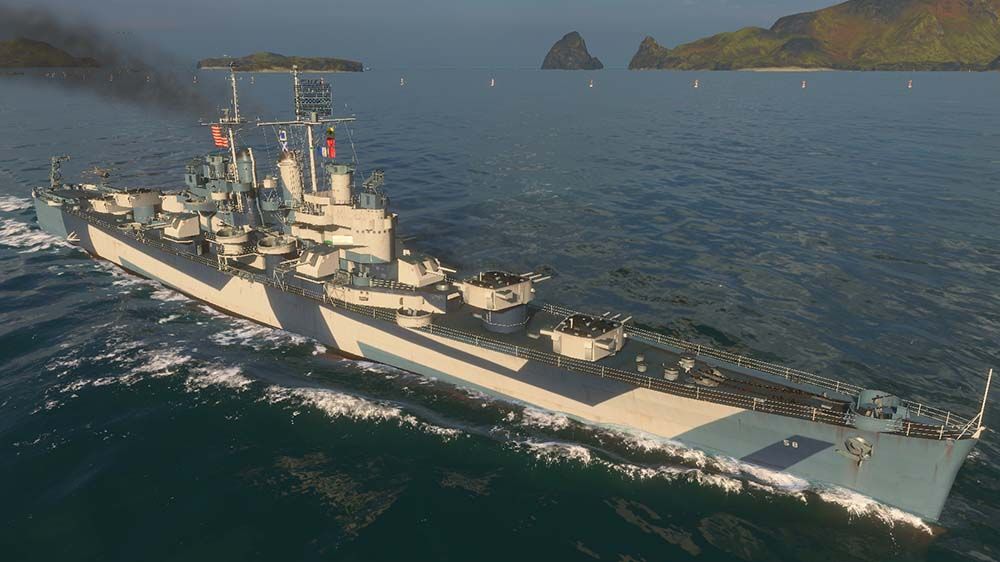
Model Kits Corner
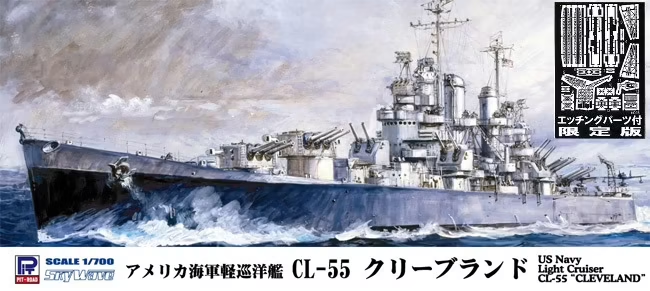
On Scalemates
-The scale shipyard produced on demand 1:96 models of any Cleveland ship for RC.
-USS Cleveland CL-55 U.S. Navy Light Cruiser Blue Ridge Models 1:350
-USS Miami CL-89 (1944) ex-Gulfstream Models kit Iron Shipwrights 1:350
-USS Birmingham CL-62 Very Fire 1:350
-U.S.S. Springfield With “Terrier” Guided Missiles FROG 1:500
-USS Galveston CLG3 with “Terrier” guided missiles Renwal 1:500
-U.S.S. Springfield Revell 1:500
-USS Manchester Lindberg 1:600 (and many others)
-1:700 USS Cleveland CL-55 Blue Ridge Models/midship models 1:700 (many too)
-USS Galveston CLG-3 1968 Niko Model 1:700
-CL-89 Miami w/Photo-etched parts Pit-Road 1:700
-U.S.S. Houston CL-81 Lindberg 1:1080 (and others)
-U.S S. Houston Crucero NorteamericanoNecomisa 1:1080
-USS Columbia CL-56 (1943) Hansa 1:1200
-USS Vincennes CL-64 Navis – Neptun 1:1250
-Many 3d printed parts Model Monkey 1:350
The Cleveland class in action
Note: The pennant list seems incomplete: That’s because of all hulls laid down, ten were reordered as CVLs (Independence class) with the new pennants CVL-22, 23, 24, 25, 26, 27, 28, 29 and 30 (former CL-59 Amsterdam, CL-61 Tallahassee, CL-76 New Haven, CL-77 Huntington, CL-78 Dayton, CL-79 Wilmington, CL-85 Fargo, CL-99 Buffalo, CL-100 Newark). Others saw their contract cancelled in December 1940: USS Buffalo (CL-84), Newark (CL-88), and Youngstown (CL-94).
 USS Cleveland (CL-55)
USS Cleveland (CL-55)
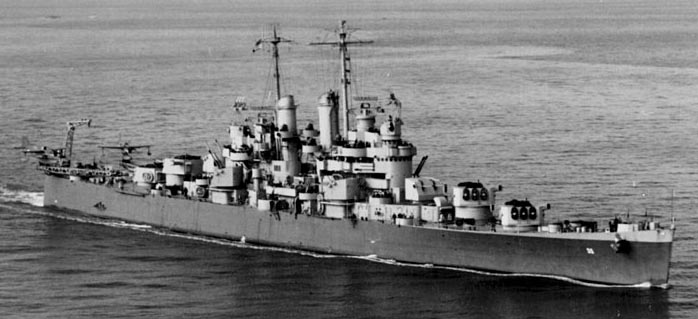
USS Cleveland underway at sea in November 1942, Operation Torch
After being commissioned on 15 June 1942, with Captain E. W. Burrough as first captain, and making quick sea trials, USS Norfolk was sent in Chesapeake Bay for advanced training from 10 October 1942. In November she sailed to join a task force off Bermuda, bound for the invasion of North Africa. She covered the landings at Fedhala in French Morocco (8 November) and stayed there until 12 November, before going back to Norfolk on 24 November 1942. She sailed for the Pacific on 5 December 1942, stopping at Efate Island on 16 January 1943. She saw first the Solomon Islands campaign with Task Force 18, escortung a troop convoy bound to Guadalcanal. From 27 to 31 January, she shelled Japanese positions on the island and patrolled, while later fending off air atacks in the Battle of Rennell Island (29–30 January). She then joined TF 68 to be soon found involved in the battle of “the Slot”, on 6 March 1943. After shelling Japanese airfields at Vila (Kolombangara) she shelped sinking the destroyers Minegumo and Murasame durring the night (battle of Blackett Strait).
Captain Andrew G. Shepard took command in June and she covered with the TF 68, the “Merrill’s Marauders”, bombading the Shortland Islands on 30 June 1943, provided close support during the invasion of Munda (New Georgia) on 12 July.After maintenance and crew’s rest at Sydney she was back off Treasury Islands for the 26–27 October preparatory shelling. She then moved on Buka Island and the Bonins, on 1 November 1943, in support the invasion of Bougainville. She shelled also bases in the Shortlands and intercepted the relief night Japanese force (“Tokyo Express”) in what became the Battle of Empress Augusta Bay, gaining a Navy Unit Commendation.
USS Cleveland poured showed the accuracy of her modern controlled fire by crippling all Japanese cruisers for over an hour, almost single-handedly destroying IJN Sendai, and chasing the rest until daybreak. She later repelled a morning air attack and was rocked by several near-misses. Back off Buka she made another bombardment on 23 December 1943 before being sent patrolling between Truk and Green Island in Papua New Guinea, until 18 February 1944.
She cover the invasion on Emirau Island (17-23 March) and was replenished and maintained at Sydney to be back to the Solomons on 21 April 1944, in preparation for the Marianas operation. She made a run of practice bombardment on 20 May, surprised to be shot back by useen IJN coastal fortifications that she quickly silenced. From 8 June to 12 August she was in the Marianas, starting on 24 July with the invasion of Tinian, helping there and assisting the crippled destroyed USS Norman Scott, hit by shore batteries. USS Cleveland interposed herself in front of the shore batteries while conducting precised fire to silence them, also making softening-up bombardments and then gave fire support for invading troops until she joined TF 58 for the Battle of the Philippine Sea on 19–20 June. Although few enemy aircraft penetrated the screen of American carrier planes, Cleveland was credited on demand. She also shot down an aircraft, assisting shooting another.
On 12-29 September 1943, was part of the invasion of the Palaus. Afterwards she sailed to Manus Island on 5 October then sailed to the US for a major overhaul which lasted almost a year. She was back in the Philippines, Subic Bay, on 9 February 1945. She made a sortie against Corregidor on 13–14 February, destroying the fortress which was later assaulted. She was present in all others Philippines campaig operations, covered landings at Puerto Princesa, but also the Visayas, Panay, Malabang-Parang on Mindanao. Back in Subic Bay on 7 June she covered other operations on demand, then sailed for more fire support at Brunei Bay, Borneo on 10 June 1944. After resplenishing at Subic Bay on 15 June, she was in Manila, carrying Army Douglas MacArthur and his staff for the assault on Balikpapan. She started a pre-landing bombardment the next morning, 31 June, and headed back for Manila on 3 July.
On 13 July she joined TF 95 to Okinawa on 16 July. She made sweeps against Japanese shipping until 7 August. She was back to Okinawa on 9 September, supporting the last operations, and preparing for the invasion of Japan. She made a POW repatriation run from Wakayama, and stayed in the naval occupation group until the 6th Army landing on Honshū. She visited Tokyo Bay on 28 October to 1 November 1945 before going back to Pearl Harbor, and then San Diego, and via the Panama Canal Boston (5 December) for an overhaul. Training exercises followed in 1946-47, notably with the Naval Reserve, between the Carbbean and Halifax in Nova Scotia, also visiting and Quebec in June 1946. She was back in Philadelphia for inactivation, decommissioned and in reserve from 7 February 1947. Judged already well-battered, the lead ship of the class, awarded 13 battle stars, stayed in long term reserve until sold for scrap on 18 February 1960.
 USS Columbia (CL-56)
USS Columbia (CL-56)
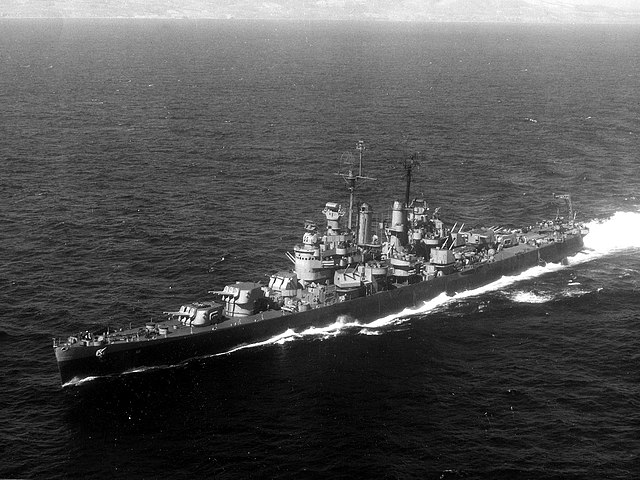
USS Columbia off San Pedro, 1945
USS Columbia was built at the New York Shipbuilding Corporation, Camden, New Jersey, launched 17 December 1941 and Commissioned on 29 July 1942 under command of Captain W. A. Heard, starting accelerated sea trials and training until November. On 9 November 1942 she departed Norfolk for Espiritu Santo in the New Hebrides (10 December) starting her Guadalcanal campaign. On 29 January 1943 while off Rennell Island, covering transports she had her first heavy air attack. The battle of Rennell Island saw her splashing down three enemy planes. She was based in Efate from 1 February 1943 and went on patrolling the Solomons until June. She carried out a shellins and als a minelaying mission on 29–30 June in relation to the attack on New Georgia. On 11–12 July she shelled Munda and was later in maintenance at Sydney, back in September to patrol southeast of the Solomons.
USS Columbia was back in her division on 24 September, off Vella LaVella. She later covered Marines on Bougainville (1st November 1943), shelling Buka and Bonis (Shortlands). During the night they intercepted a Japanese group, which became the Battle of Empress Augusta Bay Columbia helpping to sink (with her suister ship Cleveland) IJN Sendai and the destroyer Hatsukaze. She stayed in support off Bougainville in December as well. After training in the New Hebrides by January 1944, she spearhead the attack and occupation of Nissan (Green Islands) on 13-18 February 1944. In March 1944 her group patrolled between Truk and Kavieng, searching for enemy shipping. She covered afterwards the assault on the Emirau Island (17-23 March) and on 4 April stopped at Port Purvis (Solomons) before heading for San Francisco, for an overhaul that lasted until her return to the Solomons on 24 August 1944, back to Port Purvis.
USS Columbia made a sortie on 6 September with the covering force bound for the Palau islands. She remained off Peleliu, providing gunfire support and protecting shipping until back to resupply in Manus on 28 September. She was back in cover on 6 October, and moved to the assault on Dinagat and other islands, cericling Leyte Gulf, until 17 October. Then USS Columbia provided gunfire cover on the 19th, and participated in the night of 24 October to repelling the southern force entering Leyte Gulf (Battle of Surigao Strait). Columbia teamed with Oldenburg’s battleships division, crossing the T of the incoming Japanese column with devastating results. She helped crippling Yamashiro, firing away on Mogami and other ships. Columbia sank by herself the destroyer Asagumo.
She replenished at Manus in November and was back in Leyte Gulf mostly for air attack cover. By December she was in the Kossol Roads, Palaus, covering the attack on Mindoro. On 14 December 1944 she had an accidental 5-inch (127 mm) misfire, killing four. On 1st January 1945, USS Columbia operated in the Lingayen Gulf and on the 6th participated in the pre-invasion bombardments. Soon the first of many massive Japanese kamikaze attacks started. She first was shook by a near miss to be then struck on her port quarter. The plane and its bomb penetrated two decks before exploding. The immediate result was 13 killed and 44 wounded while both her aft turrets were out of action.
Blazing hard, only flooding of the two magazines prevented other explosions. Damage control teams did wonders however and Columbia was soon in full control, and resumed her bombardment with her forward turrets. She remain in close support also for night underwater demolition teams. Dried ammunition was carried forward by hand. On 9 January USS Columbia could not manoeuver and was struck by another kamikaze. It knocked out six gun directors, killing 24 men, wounding 97, but the new fire was soon mastered again and she was back in action. That night however her captain decided it was enough and sailed her out, escorting unloaded transports. The actions of her safety team won her a Navy Unit Commendation.
She was first repaired at San Pedro Bay in Leyte before sailing for her overdue overhaul on the west coast. She was back from the US on 16 June 1945 and headed for Balikpapan in Borneo, dropping anchor there for gunnery support on 28 June, the assault starting on 1st July. She covered Australian troops, giving close on-demand artillery support until departing to join Task Force 95 sweeping the China sea in search of Japanese shipping. Later she carried inspection parties to Truk when the war ended, and carried Army passengers between Guam, Saipan, and Iwo Jima. On 31 October she sailed for home, the west coast, Philadelphia, arriving on 5 December. An overhaul plus training the Naval Reserve follwoed, until 1 July 1946. Decommissioned, she was placed in prolongated reserve at Philadelphia on 30 November 1946. She stayed there until sold for scrap on 18 February 1959. In addition to the Navy Unit Commendation, Columbia received 10 battle stars for World War II service, her motto was “Gem of the Ocean”.
 USS Montpelier (CL-57)
USS Montpelier (CL-57)

USS Montpelier, launched on 12 February 1942 (named after Montpelier, Vermont), was commissioned on 9 September 1942 under command of her wartime Captain, Leighton Wood. After an express shakedown cruise she was bound for Nouméa in New Caledonia to prepare operations against the Solomons. She departed Norfolk as flagship of Cruiser Division 12 (CruDiv 12) on 18 January 1943, with Rear Admiral A. S. Merrill on board. On 25 January she was in Efate in New Hebrides, her home base. During a sweep of Guadalcanal, she participated in the Battle of Rennell Island (last naval engagement of the whole Campaign), and covered the landings on the Russell Islands on 21 February. On 5–6 March she shelled Stanmore airfield (Kolombangara) and took part in the Battle of Blackett Strait. She also shelled Poporang Island on 29–30 June and Munda fortified positions on 11–12 July, then the conquest of New Georgia, patrolling the area to prevent withdrawals.
She made a stop for respenishing and the crew’s rest in Sydney, Australia, and joined TF 39 as flagship again, for the invasion of the Treasury and Bougainville Islands. On 1st November she shelled the Buka and Bonis airfields (northern tip of Bougainville), Poporang and Balalae islands (Shortlands). She also took part in the Battle of Empress Augusta Bay on 2-3 November 1943 under command of Admiral Merrill. Montpelier’s gunners also claimed their first five “bogeys”.
After some rest and resplenishment, on 15–19 February 1944 USS Montpelier covered the Green Islands assault (Bismarck Archipelago) and in March, she patrolled south of Truk and covered the invasion of the Emirau Islands. On 20 May 1944 she was hit by shore batterues when shelling Japanese shore installations on Shortland, Poporang, and Magusaiai. On 1st October 1944 she teamed with the Special Air Task Force (SATFOR) for the assault on Saipan, starting pre-invasion shelling on 14 (Mariana Campaign). She later joined TF 58 and took part in Battle of the Philippine Sea (19–21 June) before returning to shelling Saipan, Tinian, and Guam. She then left for the US and her major wartime overhaul.
She was back on 25 November in Leyte Gulf, attacked by a kamikaze on 27 November, and near-missed. She repelled many other kamikaze attacks and splashed four more, while on 12 December covering the assault on Mindoro. She also provided AA during the Lingayen Gulf landing (January 1945) and the newt month she was off Mariveles Harbor, Corregidor and shelled Japanese positions in Palawan. On 14–23 April, she covered the attack on Mindanao and sailing from Subic Bay she took part in the operations of Borneo on 9 June.Until 2 July 1945, she covered operations at Balikpapan and until early August she made three anti-shipping patrols in the East China Sea with TF 95.
She was in Wakayama in Japan, when the war ended, soon making her first trip back home with POWs. Part of her crew viewed the ruins of Hiroshima. On 18 October, she covered landings at Matsuyama and departed Hiro Wan on 15 November for her run to the East Coast, via Hawaii, to San Diego. She went through the Panama Canal to be in New York City for a parade. On 1st July 1946 she was with the Atlantic 16th Fleet for a time, before being decommissioned and placed into the long term reserve in Philadelphia from 24 January 1947. She was never “woke up” and was stricken in 1959, BU 1960. During her campaign she was awarded 13 battle stars.
 USS Denver (CL-58)
USS Denver (CL-58)
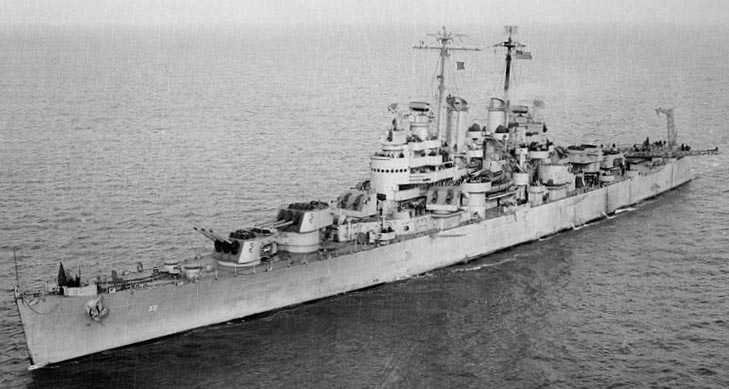
USS Denver Underway, circa December 1942. Photograph from the Bureau of Ships Collection in the U.S. National Archives.
USS Denver was commissioned on 15 October 1942, with Captain Robert Carney in command. She sailed from Philadelphia on 23 January 1943 for Efate in New Hebrides, this time under command of Thomas Darden. Her actions included the Vila (Kolombangara) attack on 6 March, co-sinking Minegumo and Murasame at Blackett Strait; Ballale Island (29–30 June) in New Georgia and sorties with TF 39 at Cape Torokina (Bougainville), battle of Empress Augusta Bay in which she was hit by three 8-inch shells, failing to detonate. She earned a Navy Unit Commendation. Off Cape Torokina (November 1943) she was hit by an aerial torpedo, knocking out all power and communications onboard, killing. She was towed by USS Sioux to Port Purvis, then Pawnee (Espiritu Santo) until able to sail to Mare Island for permanent repairs.
She was back at Eniwetok on 22 June 1944, then attacked the Bonins and Marianas, bombarded Iwo Jima on 4 July and back to Eniwetok in August. In September she shelled Angaur Island and covered a minesweeping action before the landings on Ulithi (23 September). On 12 October she covered the landings on Leyte, shalling Suluan Island and Dulag, then the southern landing beaches. She took part in the Surigao Strait battle on 24 October, co-sinking IJN Yamashiro and later IJN Asagumo on 25 October.
Still in Leyte Gulf, she guarded the TF agains Kamiikaze attacks taking a hard near-miss 28 October causing minor damage and flooding. In another attack on 27 November she had four wounded due to fragments of an explosion 200 yards (180 m), starboard quarter. She covered the Mindoro landings (13–16 December), and from San Pedro Bay on 3 January she covered the landings at Lingayen Gulf and the Zambales on 29–30 January, Nasugbu 31 January, before escorting a convoy to Mindoro (1-7 February), and covering landings around Mariveles Bay (13-16 February) rescuing survivors of USS La Vallette then shelling Palawan and Mindanao until May 1945.
On 7 June 1945, USS Denver covered the assaults on Brunei Bay (Borneo) and Balikpapan and another action on Leyte on 4 July, after a brief overhaul. She was off Okinawa on 13 July, and hunting Japanese shipping with TF 95, until 7 August. She made a POW run from Wakayama, covered the landing at Wakanoura Wan, before arriving at Norfolk on 21 November 1945. After another overhaul she was used in Newport, Rhode Island by January 1946 for training the Naval Reserve, and visiting Quebec. Back to Philadelphia NyD she was placed in long reserve from 7 February 1947 until Stricken on 1 March 1959 and sold for BU in February 1960. For her service she was awarded a Navy Unit Commendation and 11 battle stars.
 USS Santa Fe (CL-60)
USS Santa Fe (CL-60)
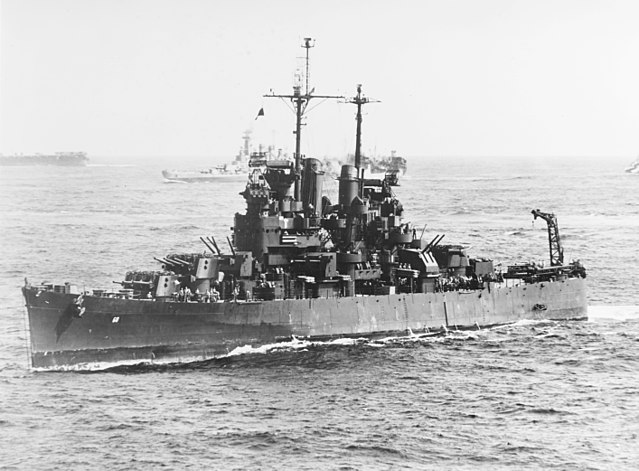
USS Santa Fe 12 Decmember 1944
USS Santa Fe was commissioned on 24 November 1942, with Captain Russell S. Berkey in command and after her shakedown cruise on the east coast, she sailed for the Pacific, first Pearl Harbor on 22 March 1943 and then north, to the Aleutians. On 25 April 1943, after six days there she shelled Attu Island, under Japanese occupation. For four months afterwards she patrolled the Aleutians in case of IJN reinforcements, with shellings of Kiska on 6 July and 22 July. Gunfire support for invasion started on 15 August. She departed on 25 August back to Pearl Harbor and prepared to join Cruiser Division 13, fast carrier task forces, spearheading the island hopping campaign. She escorted two carrier from Pearl Harbor bound to Tarawa (18–19 September) and Wake (5–6 October). Back to Pearl, she departed again on 21 October, detached to escort transports reinforcing Bougainville. She was there on 7 November, protecting her force from furious air attacks. After a resplenishment at Espiritu Santo on 14 November she escorted another force to the Gilbert Islands and at the end of the month shelled positions on Tarawa bfore joining the fast carrier force on 26 November bound to Kwajalein, arriving on 4 December, anc back to Pearl Harbor.
She was absent the first weeks of 1944, back home for an overhaul and trained for coordination firing in future amphibious operations off San Pedro in California. On 13 January she sailed with the task force to the Marshall Islands. On 29 January she shelled Wotje and then Kwajalein, called for close gunfire support during the invasion and resplinishing at Majuro on 7 February 1944. She assisted her force raiding Truk on 16–17 February, Saipan on 22 February. After a stop at Espiritu, she sailed again on 15 March with USS Enterprise and Belleau Wood bound for Emirau Island. She shelled Palau, Yap, and Woleai and on 13 April, escorted USS Hornet(ii), in support of the landings at Hollandia in New Guinea. It was over on 28 April and she covered a new raid on Truk, Satawan, and Ponape until 1st May, before resplenishing at Kwajalein.
Santa Fe assisted in the Marshalls USS Bunker Hill durng raids on Saipan, Tinian, and Guam (11–16 June). On 19 June, IJN aviation fell on the 5th Fleet and USS Santa Fe AA crew contributed to splash many planes. On the night of the 20-21 USS Santa Fe turned on her lights to help guide American planes back to their carriers. A raid on Pagan Island followed on 24 June, a resupply at Eniwetok. Back to Hornet’s group she covered a raid on Iwo Jima on 4 July followed by Guam and Rota, Yap and Ulithi, then Iwo Jima again (4-5 August) while defeating a small relief Japanese convoy (IJN Matsu sunk). She reupplied at Eniwetok on 11 August and from 30 August 1944 to 26 January 1945, she joined the USS Essex Carrier Group: Strikes on Peleliu, Mindanao, second Japanese convoy intercepted, raids on the Visayan Sea and other positions in the Philippines and the TF anchored in the Kossol Passage (Palaus) on 27 September 1944.
New attacks on Okinawa and Formosa in October followed, but on 13 October, Canberra and Houston were torpedoed and Santa Fe, Birmingham, and Mobile were detached to help tow these out. On 16 October underway, she was attacked by a group of Toprpedo bombers, one dropping its torpedo into the wake. Hit, the same tried to crash on her bow but hit the water (starboard bow) but showering flaming gasoline on the 20 mm guns with Marines and one sailor, two of USS Houston survivors burned. On 17 October she was back with the carrier force, supporting the Leyte landings. The Essex group next raided the Visayan airfields and searched for Japanese naval forces reported approaching.
There was a massive air attack on 24 October, on getting htough and ropping its bomb on the USS Princeton (eventually lost but assisted by USS Birmingham). North of Luzon the decoy carrier force was spotted, ptompted the departur of the 5th fleet and Santa Fe was part of a battle group of six battleships and seven cruisers. Later they fell on the forces that swept through San Bernardino Strait. Four cruisers of CruDiv 13 (its commander raised his mark on USS Santa Fe) went north and catched previously damaged ships by air attack, finishing off the CV IJN Chiyoda, destroyer Hatsuzuki (lefotover of the Battle off Cape Engaño). Santa Fe was back with the carriers and to Ulithi on 30 October.
The Essex group was diverted en route to Manus to the Philippines because of another report, later proved false. Santa Fe’s group hit Manila (5–6 November 1944), repelling a kamikaze attack. During their resplenishement at Ulithi the cruisers were attacked by midget submarines. USS Mississinewa was sunk, some survivors later picke dup by Santa Fe’s floatplanes. The Essex group was back in action on 22 November, until 1 December in the Philippines. They supported newt the the Mindoro landings but the whole fleet was hit by the Typhoon Cobra, which sank three destroyers, on 18–19 December.
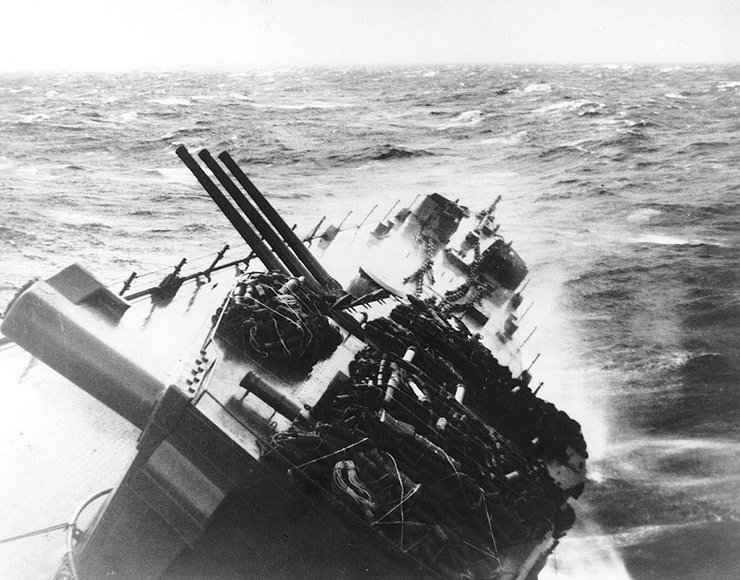
USS Santa Fe’s bow at high angle in December 1944, Typhoon Cobra
On 30 December 1944, the Essex group raided Formosa and Okinawa (3–4 January 1945), then Luzon, Formosa again and the South China Sea (Indochina coast, China coast, Formosa again (21 January), and Okinawa before resplenishment in Ulithi. Next USS Santa Fe was reaffected to the USS Yorktown(ii) group on 10 February. On 16–17 February she covered the first raids around Tokyo. Santa Fe was detached on 18 February to shell Iwo Jima (19-21), notably trying to destroy batteries on Mount Suribachi and firing illumination shells at night. She was back to protect the carriers of another Tokyo raid on 25 February.
On 14 March, she joined the USS Hancock group, attacking Kyūshū (18 March), Kure and Kobe. She witnessed the Franklin’s agony, and maneuvered alongside the crippled carrier to rescue survivors and fight fires with her pumps, still at safe distance. For nearly three hours she rescured 833 survivors and help mastering major fires, while USS Pittsburgh took her in tow to Ulithi, Santa Fe staying in sclose escort. On 27 March she escorted her to Pearl Harbor, receiving a Navy Unit Commendation for her assistance: Captain Harold C. Fitz was awarded the Navy Cross, three sailors Silver Stars.
To this occasion the tired, but not battered cruiser was sent for an Overhaul at San Pedro until 14 July 1945. Back to Pearl Harbor on 1 August she departed on 12 August with USS Antietam and USS Birmingham, to attack Wake but the raid was canceled on 15 August as Japan capitulation was known. Instead they headed for Eniwetok and Okinawa, Buckner Bay (26 August) before departing for Sasebo (20 September). In October and until 10 November, she covered the forces occupying the northern Honshū and Hokkaidō and made two “Magic Carpet” trips from Saipan, Guam, and Truk. Her last voyage ended on 25 January 1946 at Bremerton. She was decommissioned on 29 October and preserved in the US Pacific Reserve Fleet, but struck on 1 March 1959, sokd for BU. For her service she earned 13 battle stars.
 USS Birmingham (CL-62)
USS Birmingham (CL-62)
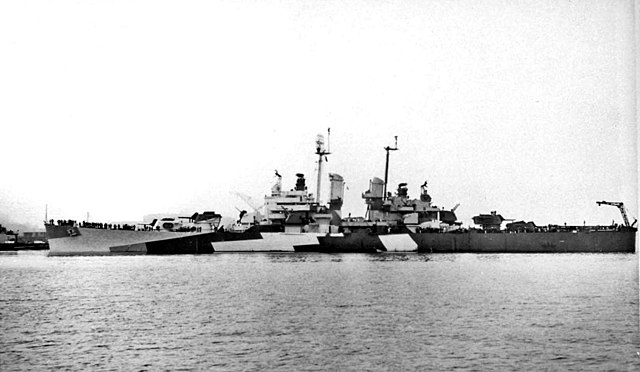
USS Birmingham off Mare Island, and her first repairs ready to join the fray again on 7 February 1944
Following her shakedown cruise, USS Birmingham was assigned to the Atlantic Fleet and departed Norfolk on 7 June 1943 for the Mediterranean front, starting with providing gunfire support for the invasion of Sicily on 10–26 July 1943. Back home on 8 August, she was sent to the Pacific Fleet, making it in Pearl Harbor on 6 September 1943. Son, she joined like most of her sister ships the fast carrier task force screen created by CVLs base don the same hulls.
She took part in the raids on Tarawa on 18 September 1943, Wake on 5–6 October, took part in the Battle of Empress Augusta Bay with Cleveland, Columbia, Montpelier and Denver. Her first major action while her AA gunners also claimed their first four enemy Japanese aircraft. During one such attack she was hit with two bombs and a torpedo and casualties included two killed and 34 wounded. She retired for repairs and kept out the following night battle that followed. USS Birmingham was back to Mare Island NyD for repairs, until 18 February 1944 when she was assigned to Task Force 58 and soon took part in the Battle of Saipan on 14 June – 4 August.
She was also involved in the Battle of the Philippine Sea on 19–20 Jun, the Battle of Tinian on 20 July until 1 August, the Battle of Guam on 21 July, the Philippine Islands raids on 9–24 Septemberbefore being assigned to TF 38. She participated in the Okinawa raid on 10 October and strikes on northern Luzon and Formosa until 19 October followed by the Battle of Leyte Gulf (24 October). At this occasion, she tried to help the best she could the crippled USS Princeton, famously almost berthed alongside to help rescure survivors and combat fires. However she suffered great topside damage as multiple explosions rocked the aircraft carrier. In all, 239 died, 408 were wounded, plus four missing. USS Birmingham, crippled herself critically was to be retired, heading to Mare Island NyD. Extensive repairs lasted from November 1944 to January 1945.
She was back in the Pacific in time to supported the battle of Iwo Jima on 4–5 March 1945, assigned later to joined Task Force 54 deployed in the invasion of Okinawa berween 25 March and 5 May 1945. On 4 May 1945 after fending off three Kamikaze attacks, the unlucky cruiser was damaged when one kamikaze hit her forward section, which caused a detonation killing 47, 81 wounded and 4 missing. She returned under escort to Pearl Harbor, with repairs starting on 28 May and completed on 1st August. By the time she gained quite a reputation, but joined the 5th Fleet still operating off Okinawa on 26 August.
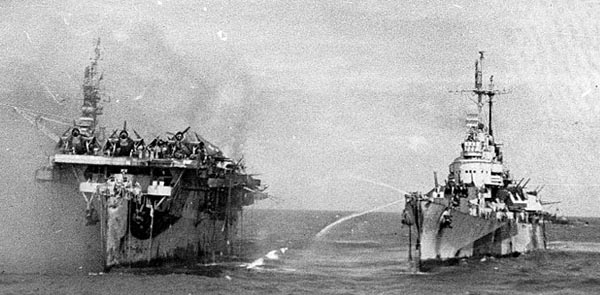
USS Birmingham comes alongside the burning USS Princeton to help, in denial of her own safety, the most courageous and dramatic event for the whole Cleveland class.
The was war had ended since almost a week and she stayed to cover convoys bound to mainland Japan, proceeding with the occupation. In November 1945 however steamed to Brisbane in Australia and visited other ports, notably Melbourne on 8 November 1945. Back to San Francisco on 22 March 1946 she was decommissioned, placed in prolongated reserve on 2 January 1947. The most batterred cruiser of the class certainly was not to be recommissioned and indeed she was stricken from the Register on 1 March 1959, scrapped at Long Beach. She won 8 battle stars for her service and would have gained more if not a “magnet” for enemy ordnance, with long repair intervals.
 USS Mobile (CL-63)
USS Mobile (CL-63)
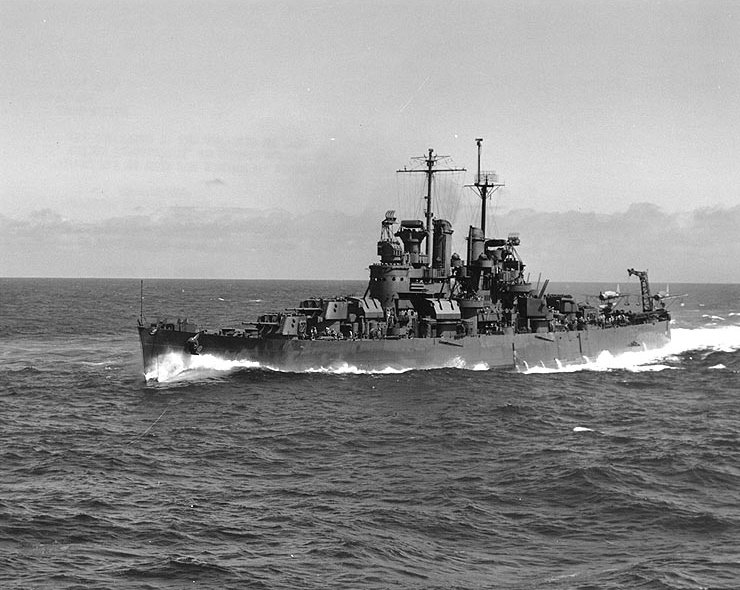
USS Mobile underway in the Pacific Ocean, October 1943.
An early Cleveland class ship, USS Mobile was commissioned on 24 March 1943, with Captain Charles J. Wheeler in command. Following a Chesapeake Bay shakedown cruiser and brief training to Casco Bay, she departed for the Pacific, arriving Pearl Harbor on 23 July 1943 for a month of further training. On 22 August, she was assined to Task Force 15 raiding Marcus Island, on 31 August. She made two other fast carrier raids from Hawaii and joined the 5th Fleet deployed in the Gilberts islands, still screening the CVLs of TF 15 falling on Tarawa Atoll (18 September) and TF 14 on Wake (5–6 October). On the 21 she joined Task Group 53.3 and on 8 November operated off Bougainville Island and later was based at Espiritu Santo, from which she joined TG 53.7 for the attack on Tarawa and Betio (20–28), remaining in the for close support. On 1st December, USS Mobile was ordered to join TF 50 of the Fast Carrier Forces, later conglomerated as TF 38/58. She covered actions at Kwajalein and Wotje before a refill at Pearl Harbor and San Diego, assigned to escort duty for the 5th Fleet on 29 December 1943.
The new year she sailed mi-dJanuary with TG 53.5 back to the Marshalls and the 29 joined CruDiv 13 shelling Wotje and back to Kwajalein. Until 6 February she operated off Roi-Namur and refilled in Majuro latere joining TF 58.
The fast carrier forces she escorted prevented any rinforcement of bypassed small enemy-held atolls and islands, isolate those to be captured. After the occupation of Eniwetok and encirclement of Rabaul, TF 58 headed for the Carolines and operations started on 16–17 February on Truk, before heading northwest to the Mariana for striked on Saipan, Tinian, and Guam until 21–22 February. TG 58.1 became TG 36.1 on 12 March and three days later, covered the Marines assaulting Emirau on 20 March 1944. Until 3 April Palaus, Yap, and Woleai followed, with the usual respite at Majuro. Next were Aitape, Humboldt Bay, Tanah Merah Bay (New Guinea Camoaign) then attacks on Wakde and Sawar Airfield (21–22 April) for the Battle of Hollandia. After a new raid on Truk and Satawan, Ponape followed on 1st May.
On 11 June, USS Mobile operated in the Marianas for more strikes on Saipan, Tinian, Guam, and Rota, Volcano and Bonin Islands to isolate the archipelago.On 19 June she took part in the first Battle of the Philippine Sea. USS Mobile afterwards launched everyday her OS2U Kingfishers for antisubmarine or SAR missions. On 23 June, the carrier force retired to Pagan Island for new strikes. On 30 June, they headed for new raids on Bonin and Volcano Islands and back to the Marianas campaign, Guam, Rota and on 23 July, raids on the Western Carolines, Yap, Ulithi, and Fais, Palaus and back to Saipan on 2 August 1944.
New raids followed on the Bonin and Volcano Islands, CruDiv 13 and Destroyer DesDiv 46 were detached to search for Japanese traffic in the Chichi Jima area. USS Mobile participated in the sinking of a destroyer and large cargo vessel. The shellling of Chichi Jima followed. Her unit was renamed TG 38.3 and was back in the Palau Islands on 6-8 September before a raid to Mindanao and Visayas, the Peleliu and Angaur, and back to Philippines, hitting the Manila area, and Visayas again.
After the usual resuply at Ulithi operations on the Ryūkyūs islands followed, while USS Mobile was detached with USS Gatling and Cotten to destroy two located enemy ships some 30 miles (48 km) away and indeed sank a large cargo ship, while the other already was sunk by aviation. Back with their unit they raided Formosa and the Pescadores. On 13 October they escorted the damaged cruisers Canberra and Houston (“Cripple Division 1”) back to safety. USS Mobile was back to TG 38.3 on 17 October 1944, and after striked on the Visayas and southern Luzon a masive plane attack from Vice Admiral Jisaburō Ozawa’s Mobile Fleet commenced and during the ensuing battle of Leyte gulf, USS Mobile protected USS Princeton. Next she fought the Battle off Cape Engaño and aided in sinking IJN Chiyoda and Hatsuzuki. She went on operating in the Philippine until retiring at Ulithi and sailing again on 26 December for the west coast, Terminal Island in California for a well-deserved overhaul and long crew leave.
USS Mobile received alteration and modernizaztion, notably for her radar and AA before heading back to Ulithi on 29 March 1945, attached to Task Force 54 and prepared for the assault on Okinawa, arriving on 3 April. She provided fire support and AA cover, her own planes providing also antisubmarine patrols and tasked to spot and destroy Shinyo suicide boats. By the fall of May 1945, USS Mobile was reassigned to TG 95.7 and complete the Philippine training group, in action until August. On 20 August, she sailed San Pedro Bay for Okinawa and Japan, helping the occupation and making POW transport home runs to San Diego. She made another “Magic Carpet” run until joining Puget Sound for inactivation, decommissioned on 9 May 1947, Reserve Fleet until 1 March 1959, stricken and sold for BU. She won 11 battle stars for her service.
 USS Vincennes (CL-64)
USS Vincennes (CL-64)
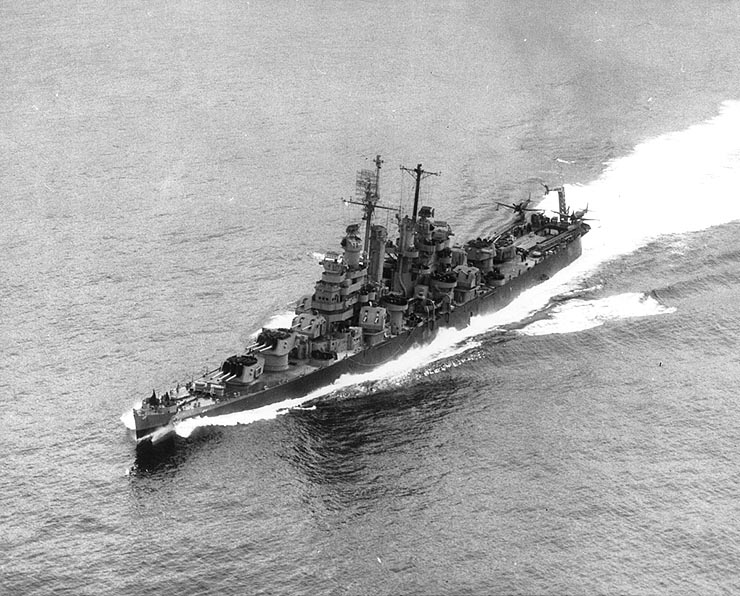
USS Vincennes underway in San Francisco Bay 29 August 1945
USS Vincennes(ii) – the first was a New Orleans clas cruiser sunk at the infamous “ironbottom sound” during a famous night action in 1942 – was commissioned on 21 January 1944 with Capt. Arthur D. Brown in command. By late February 1944 she made her sea trials and her shakedown cruise in the British West Indies and back followed by training in the Chesapeake Bay area, and Gulf of Paria near Trinidad. She became flagship for Commander, Cruiser Division (CruDiv) 14, Rear Admiral Wilder D. Baker. On 16 April she departed with USS Miami and Houston Boston from Boston, heading for Panama and Pearl Harbor on 6 May 1944. After more training, CruDiv 14 and USS Vincennes hosted Admiral Chester W. Nimitz on board. On 24 May the division left Pearl Harbor to Majuro (Marshall) and Task Force 58 (Vice Admiral Marc A. Mitscher) for the Mariana campaign.
USS Vincennes’s first action was in the Bonins, splashing Japanese aircraft, downing a Mitsubishi G4M “Betty” bomber on 10 June 1944. She covered raids on Saipan and Pagan Islands, Iwo Jima and took part in the Battle of the Philippine Sea. On 23 June, Rear Admiral Baker raised his flag on USS Miami while Vincennes refilled at Eniwetok and some repairs. She was back to CruDiv 14, Rear Admiral Baker making her his flagship again on 7 July. She operated off Guam and Tinian, Rota, then the Marianas, anchoring off Saipan and depating again on 1 August for an attack on the Bonins. Rear Admiral Francis E. M. Whiting relieved Admiral Baker and CruDiv 14 was affected to TF 34, making at the end of August tactical and gunnery exercises and joining TG 38.2 on 3 September 1944. After strikes on the Palau Islands she joined 38.2.5 (Rear Admiral Whiting), for shelling Japanese installations on Peleliu, Ngesebus and Angaur.
Soon she was prepared for the recapture of the Philippines, starting with Mindanao on 9–10 September and raids on Negros, Leyte, Cebu, and the Bohol Islands, and Leyte, Cebu, and Negros again at the end of September. She was back from Ulithi for actions off Okinawa on 10 October. Her AA gunners claimed a “Betty” and a Yokosuka P1Y “Frances”. Next she escorted the CVLs to Formosa, on 12 October, USS Vincennes contributing to two more bomber shot down and another by night. However Formosa was paid by the quasi-loss of the cruisers Houston and Canberra, hit by torpedoes and protected by Vincennes and Mobile, the “Cripple Division One” withdrawing to safety. Next she took part in the Battle for Leyte Gulf, heading south toward the San Bernardino Strait for expected transit and by night she took position with Miami and Biloxi plus DesDiv 103. They attacked by night helped by radars and using flares when close enough. They sank IJN Nowaki.
Later she was off the Visayas and Luzon on 28 October, repelling vigorous air attacks from the 29th, helping downing eight “bogeys”. On 5–6 Novemberstriked concentrated on Luzon and she was back to Ulithi on 9 November, before heading back for Luzon. Again, she fended off kamikaze attacks but could not prevent hits on USS Hancock, Intrepid and Cabot. Back to Ulithi she was redeployed off Luzon from 14–16 December, one of her Kingfisher pilots being so proficient at SAR missions, Lt. Halbert K. Evans, was later awarded the Air Medal.
She was caught however in the Typhoon Cobra on 18 December, but her captan skillfully manoeuvered the ship in the mountanuous waves, without serious damage, searching afterward for suvivors from the sunken USS Spence, Monaghan, and Hull. After a Christmas respite at Ulithi USS Vincennes was back in action off Formosa and sweeps in the South China Sea in early January 1945, Cam Ranh Bay in Indochina and back to Formosa, alsways with heavy Japanese air resistance. On 21 January a kamikaze hit USS Ticonderoga bad, but Vincennes and Miami downed several kamikaze but could not prevent another hit on USS Ticonderoga that day. After operations off Okinawa, USS Vincennes sailed to Ultihi for replenishment and departed 10 February to be assigned to TG 58.1. After gunnery exercises with radio control target drones, one crashed into one of her 40 mm mounts, some sailors rescuing the wounded crew and exitingushing a fire developing close to ammunitions gaining later commendation ribbons.
USS Vincennes operated against Honshū, and the Tokyo area, southern Bonin Islands. Next, Chichi Jima, Tokyo again, and Okinawa. On 1 March 1945, USS Vincennes, Miami, San Diego, plus DesRon 61 (Rear Admiral Whiting, with USS Vincennes a flagship) were detached to shell instalaltions on Okino Daito Shima. Newt followed operational training and replenishment at Ulithi and back to the battle zone mid-March. On the 18, USS Vincennes’ gunners splashed two planes during an attack ad another on the 19th. AA fire control officer, 1st Lieutenant Henry M. Lamberton, later received a Bronze Star for his direction.
USS Vincennes operated east of Okinawa (23–25 March), while her floatplanes were busy with SAR missions under enemy fire; Lt. Evans earning aoter the DFC and Lt. (jg.) George A. Greenwood and the two rear-seat men the air medal. On 1st April 1945, air attacks were massive, the cruiser helping to splash 12 enemy planes, but one crashed just 50 ft (15 m) astern. After raids on Okinawa and Kyūshū and more air attacks from 7 April she retired to Ulithi and back with TG 58.1. With USS Vicksburg from the 27 and until late May she was detached to shell Japanese targets ashore, including by night.
At the end of May her main guns delivered 5,836 rounds, secondaries 10,583 rounds, well helped by her air spotters, which were doing quite well, earning more medals. USS Vincennes fired her final salvoes on 16 June before heding for home waters and a much-needed overhaul. She was in Mare Island Navy Yard on 8 July before heading for San Diego on 29 August for post-repair shakedown and refresher training, followed by Operation Magic Carpet runs which included Noumea in New Caledonia, as flagship, Rear Admiral Paul Hendren South Pacific Area Force. She made stoped in Guadalcanal, the Russells Islands, Tulagi, Espiritu Santo and Efate followed by two trips to New Zealand and back to San Francisco, 23 March 1946 and Mare Island to be deactivated. Decommissioned on 10 September 1946, she was Struck from the list on 1 April 1966 but sunk as a target in missile experiments at Point Mugu on 28 October 1969. She earned six battle stars for her service.
 USS Pasadena (CL-65)
USS Pasadena (CL-65)

USS Pasadena was commissioned on 8 June 1944, with Captain Richard B. Tuggle in command. She made her shakedown and training cruiser during the summer of 1944, only sailing from 25 September to the Pacific, assigned to TF 38, fast carrier force gathering at Ulithi. She was caught in the Typhoon Cobra on 18 December 1944. Her operations included cover for raids against Luzon and Formosa in the Philippine campaign. By mid-January 1945 before the attack on Luzon she was in the South China Sea and Indo-China, Formosa. Now in the super-group TF 58, she covered raids on Japanese home islands, before coering landings on Iwo Jima, shelling Japanese positions and procuring on-demand gunnery interrupted by patrol duties.
After a resplenishment at Ulithi, she covered operation Iceberg, with strikes on the southern Japanese home islands and northern Ryukyus in addition to the attack on Okinawa. USS Pasadena became flagship of CruDiv 17. She took part in night bombardments of Minami Daito (28 March, 10 May 1945) alongside attacked on Okinawa and Kyūshū until 30 May 1945. She ooperated off Leyte in June, and making later her last strikes against Japanese home islands (early July 1945), then until mid-August she shelled the Japanese coast, military and industrial complexes of the Tokyo area and northern Honshū, even Hokkaidō , as part of the pre-invasion plan.
After 15 August, USS Pasadena however covered occupation forces and became flagship of TG 35.1 in Sagami Wan. She was in Tokyo Bay on 1st September at the official surrender ceremony. Until mid-January 1946 she remained there until her departure on 19 January for San Pedro, California and an overhaul. In November 1946 and until February 1947 she took part in division exercises in Micronesia, fleet maneuvers around Hawaii and backto California. In 1947 she made a crusier from the Columbia River to Portland in Oregon, the guest of Navy Day 1947. In the summer of 1948, she conducted an NROTC training cruise (naval reserve). On 1st October she was in Tsingtao and until May 1949 operated off the China coast as the Chinese civila war was about to end. On 1st June she was back to California adn after local exercises off Long Beach she headed for Bremerton and inactivation, decommissioned on 12 January 1950, stricken in 1970 and sold to a Portland, Oregon company, BU from 5 July 1972. She earned five battle stars.
 USS Springfield (CL-66)
USS Springfield (CL-66)
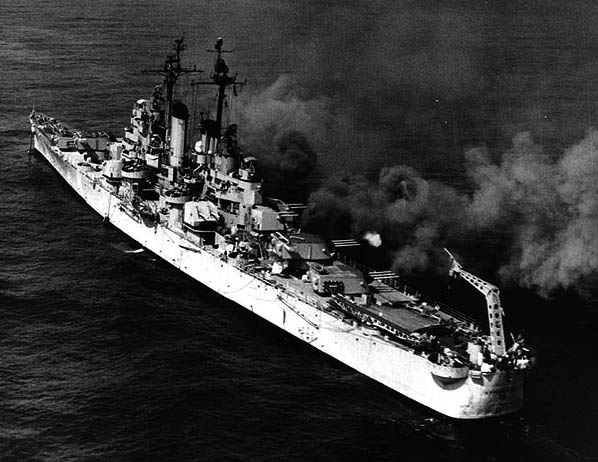
USS Springfield fires her guns, 1947
USS Springfield was commissioned on 9 September 1944 at Boston under command of Captain Felix L. Johnson. On 7 November, she made a first test cruiser, stopping at Norfolk for days of gunnery practice in the Chesapeake Bay and a shakedown cruise in the British West Indies, Trinidad. This was concluded on 21 December for a stop in Boston and fixes. She departed on 10 January 1945 for further training off Bermuda, back to Norfolk, more gunnery drills and eventually preparation for war, assigned to Task Group 21.5 off Thimble Shoal Channel, escorting USS Quincy to Malta, carrying President Roosevelt, later en route to Yalta by plane. On the 28 she headed for the Panama Canal, transiting on 5 February to Pearl Harbor, supplying and conducting AA gunnery practice. She was in Eniwetok on 2 March, then Ulithi on the 6th before joining the Fast Carrier Task Force TF 58.
For 2.5 months she operated with TF 58 against Kyūshū, Honshū, Okinawa. On 27-28 March USS Sringfield bombarded Minami Daito Shima. She was used also fir support to the invasion troops on Okinawa while still protecting the carriers, alternatiing between the east and southeast of Okinawa. Her AA gunners splashed at least three Kamikaze and more on 17 April, avoiding a near crash when she dodged a plane 50 yards (46 m) away.
On 10-11 May, departed to bombard Minami Daito Shima again and from 23 March to 28 May, accompanied TF 58 striking Japanese air bases on Kyūshū. On 30 May she was in San Pedro Bay, Leyte, for maintenance and upkeep. In July she operated with TF 38 for air strikes against the home islands and on 11 July Tokyo, later, Hokkaidō. Anti-shipping sweeps along the coast were done and night shelling on the shore as well. Kobe and Kure were hit by late July. USS Springfield shelled on 24/25 July shore installations on southern Honshū. Operations went on also on 9-10 August and until the 15th when hostilities ended.
Post-war operations wee typical for USS Springfield: In Sagami Wan with TF 35 she covered the entry of TF 31 into Tokyo Bay and assisted occupation forces, entering Tokyo Bay herself on 3 September and remaining in the area until January 1946, stopping at Sasebo, Yokosuka and Shanghai, Taku, Tsingtao, and Chinwangtao in China, Jinsen in Korea before departing Tsingtao for San Pedro in California, arriving on 25 January, entering Mare Island. She later operated along the West Coast, headed for Western Pacific, Guam, the Marianas, Kwajalein in late February, the return to Pearl Harbor in March and back to San Pedro, followed by exercizes on the West Coast over 18 months and Far East again. On 3 November 1947 she was in Yokosuka, operating with the 7th Fleet until May, 15th.
Back to the West Coast on 1st June 1949 she was later called for inactivation, San Francisco Group, Pacific Reserve Fleet in January 1950, mothballed until March 1957. She existed it to head for Boston and back to the Fore River Yard, Bethlehem Steel Co. to be converted to a Providence-class guided missile cruiser and redesignated CLG-7, from there, a second life and new career commenced.
 USS Topeka (CL-67)
USS Topeka (CL-67)

USS Topeka, underway off Boston, Massachusetts, 1 January 1945
USS Topeka was commissioned at Boston Navy Yard on 23 December 1944 under command of Captain Thomas L. Wattles, making her shakedown in the West Indies, post-shakedown repairs, and fixes and preparation in Boston on 10 April 1945 to serve with the Pacific Fleet. She headed for Oklahoma City via Culebra, Guantánamo Bay and the Canal, then Pearl Harbor (2 May 1945) and three weeks of gunnery exercises. She became flagship of Cruiser Division 18 and headed for the Western Carolines, Ulithi, on 1st June. She departed with USS Bon Homme Richard, Oklahoma City, Moale, and Ringgold, joining Task Force 38.
They were deployed for raids on the Ryukyu Islands. Kanoya on Kyūshū, then Okino Daito and a final raid wit naval bombardment on 10 June on Minami Daito. Later TG 38.1 headed to replesnigh at San Pedro Bay in Leyte. Back in action on 1st July she saw the last six-week carrier sweep on the home islands. Tokyo was raided on 10 July, Honshū and Hokkaidō newt, with antishipping sweeps off Hakodate and Muroran. Operations resumed after a refill on the southern Honshū, Tokyo area on 17th–18th. USS Topeka later joined USS Atlanta, Duluth, Oklahoma City escorted by DesRon 62 in an antishipping sweep off Sagami Nada, the entrance to Tokyo Bay. Japanese installations at Nojima Zaki were shelled. After another resplenishment on 19-23 July, new raids taks place in the Inland Sea (24-28) followed by a pause until early August.
USS Topeka still with TF 38 was deployed to face heavy concentrations of enemy aircraft spotted on northern Honshū. Raides devastating them non 9–10 August. It was learned later this group was tasked to transport 2,000 shock troops aiming at the B-29 Superfortress bases on Tinian. After another raid over Tokyo on the 12th–13th the Cruiser learned about the capitulation en route for another one.
She patrolled Japanese waters until mid-September and entered Tokyo Bay, remaining there until 1st October and headed back to the US, stopping at Okinawa to embark 529 veterans, brought to Portland, Oregon. Ten days later she was in San Pedro in Los Angeles for an overhaul until January 1946 and her return to the Far East, reaching Yokosuka on the 24th, supporting occupation forces. Se also stopped during these operations in Tsingtao and Shanghai, Manila and Guam. She was bacl to San Pedro on 20 November 1946, headed back east on 22 September 1947, making it in Yokosuka on 10 October, as part of TF 71.
She was based in Shanghai and Tsingtao and patrolled the north China coast as the civil war was coming to an end. In March 1948 she was in Nagasaki, visiting later Sasebo and Kure before heding back to the US in April, arriving in Long Beach in California on 7 May. She was overhauled for four months in Pearl Harbor before being back to the west coast, then Long Beach, San Diego until February 1949. She was inactivated in San Francisco, decommissioned there on 18 June 1949, berthed and mothballed in the Pacific Reserve Fleet.
In 1957 she has been selected for transformation. USS Topeka was towed from San Francisco to the New York Naval Shipyard (15 April) to commence conversion as a Providence-class guided missile cruiser, redesignated CLG-8. Her new cold war career started there.
 USS Biloxi (CL-80)
USS Biloxi (CL-80)
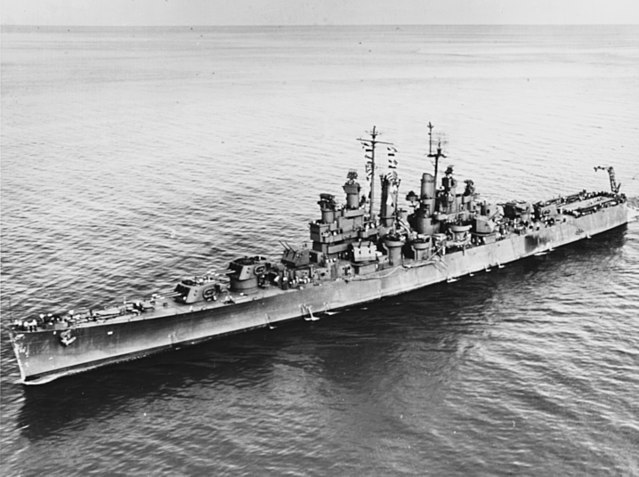
USS Biloxi underway at sea circa October 1943
USS Biloxi was fitted out at Norfolk until 17 September 1943 and started her shakedown training in Chesapeake Bay. On 29 September escorted by USS Sproston (DD-577) she sailed for Trinidad, loosing en route one of her Curtiss SO3C Seamew which crashed during a landing attempt off her port beam but the crew was rescued. Two weeks of battle drills followed and she was back on 26 October for post-shakedown overhaul and heded for the Canal on 20 November, reaching San Francisco on 4 December. She received two Vought OS2U Kingfishers and headed for Hawaii, arriving on 11 December and started other fire support exercises, at Kahoolawe Island with USS Wichita. After a stop at San Pedro for blower repairs, she joined the 5th Fleet and on 1 January 1944 sailed with USS Maryland (BB-46), Louisville (CA-28) and Mobile (CL-63) plus two destroyers operating at San Clemente Island and after a run to San Pedro, prepared for “Operation Flintlock in the Marshall Islands.
On 13 January she joined TG 53.5 in Hawaii, with Louisville, Mobile, Santa Fe and six destroyers, sailing to Wotje on 30 January. Their Kingfisher spotter aircrafts up, the bombardment commenced on the Japanese air base until noon. One Enemy shore batterie straddled Biloxi, one shell ricocheting the superstructure above the signal bridge. Shore bombardments went on also against Roi Island (Northern Attack Force) and she escorted three CVEs into Majuro lagoon on 7 January.
On 12 January she sailed with TG 58.1 (USS Enterprise, Yorktown, Belleau Wood) west for a carrier raid against Truk, a dievrsion for the New Guinean “Operation Hailstone”. She then joined TG 58.2 bound for Saipan. On 19 February an IJN recce plane was spotted and shot down, and the following night, the force was attacked by three waves of Mitsubishi G4M “Betty” and others the morning. None penetrated the CAP/AA screen, 11 shot down. The fleet retired to Majuro and was back in action on 7 March.
She escorted USS Enterprise, Belleau Wood, two light cruisers and eight destroyers to Espiritu Santo before sailing to Emirau (Bismarck Archipelago). USS Biloxi covered the landings on the 20-25th January 1944. After refuelling she joined USS Cowpens (CVL-25) and a fourth light cruiser plus nine more destroyers heading for the western Carolines. On 30 March she covered a strike on Palau, claiming a single “Betty”. She refuelled at Majuro on 6 April. On the 13 she was back with TG 58.1 deployed in Hollandia. On 21 April she covered strikes at Sawar, Wakde, and Sarmi (New Guinea). Later she shelled herself Wakde and Sawar and retired to Manus on 28 April.
After another strike north on Truk (29 April), USS Biloxi also covered a raid on Ponape, screening battleships shelling the island on 1 May. After resupplying at Kwajalein she headed for “Operation Forager” in the Mariana Islands. Sje was part of a mighty 15 fleet carriers, Task Force 58, attacking Saipan, Tinian, and Guam. USS Biloxi was part of TG 58.2 (USS Bunker Hill, Wasp, Monterey, Cabot) focusing on Saipan and Tinian. On 18 June she took up a patrol station some 150 miles west of Saipan, southern flank of the carrier forces, in which she participated in the Battle of the Philippine Sea.
On 19 June, she repelled part of the 14 enemy air raids appearing on radars, notably six Yokosuka D4Y “Judy” going through the CAP, heading for USS Bunker Hill, and she shot down at least one, in what was the “Great Marianas Turkey Shoot.” On the 20th, there was yet another 206-aircraft strike. The chase was over on the 21, the fleet retiring to Eniwetok on 27 June. Still with TG 58.1, USS Biloxi operated in the Bonin Islands with USS Yorktown, Hornet and Bataan, raiding Iwo Jima on 3 July. She drove off attacking Japanese fighters during the bombardment before the group retired.
After refueling at sea she covered striked on Guam and Rota, followed by Palau, Yap, and Ulithi. On 27 July 1944 her two Kingfishers were in the air for SAR missions as often. One (Lt(jg). R. Dana) was straddled by a Japanese AA gun, but remained unscaved and came back. After another air strike on 28 July poor weather canceled operations and the fleet headed for the Mariana Islands, resupplying at Saipan befoire another stirke on Bonin and Volcano Islands. Biloxi participated in an anti-shipping sweep later and they picked up by radar a Japanese convoy from Muko Jima, making a long range artillery fire to avoid torpedo attacks, claiming IJN Matsu and the collier Ryuko Maru. Later a Japanese “Betty” dropped a torpedo which detonated in Biloxi’s wake. The fleet was in Eniwetok on 9 August and later she was assigned to TG 38.4 (USS Franklin, San Jacinto, Enterprise, the cruiser New Orleans and 12 destroyers), tasked to neutralize the Bonins before Palau and the Philippines.
With USS New Orleans she shelled Chichi Jima and downed a Japanese “Betty”, before turning to Iwo Jima. USS Biloxi was remarked in the fleet reports for the excellence of her gunnery accuracy on 7 September. She was detache dlater to cover air strikes against Palau on 10-15 September and deploying her four Kingfishers in anti-submarine patrols. After refuellin at Manus she joined TG 38.1 proceeding to Okinawa on 8 October 1944. She operated against Formosa on 12 October and she downed one of seven “Betty” bombers with her forward 6-inch turrets AA fuse shells. She later covered strikes on Luzon, notably on 20-22 October, and joined TG 38.2 (USS Intrepid, Bunker Hill, Cabot, and Independence) east of Samar, in action during the Battle of Leyte Gulf, later steamed north off Cape Engano. During the night of 25-26, Biloxi and four other cruisers picked up contacts near San Bernardino Strait and they opened fire, claiming IJN Nowaki.
On 28 October she was back to cover actions over Luzon and Manila Bay, later plagued by Poor weather. On 15 November, USS Biloxi departed the Philippines for Ulithi, for repairs and replenishment. There was a kaiten attack on the anchorage on the 20th, which failed but sank the tanker Mississinewa (AO-59).
She was back in the Philippines on the 25th, finding off Japanese kamikaze attacks, and back again after another resupply in the Philippines on 13 December, covering the Mindoro landings with night raids shellings against airfields. On 18 December she was hit by the typhoon off Samar and suffered heavy damage, requiring repairs at Ulithi. She joined later TG 38.3 on 30 December 1944 to operate against Formosa, Nansei Shoto, and northern Luzon, starting on 3 January 1945 followed by the Ryukyus and the Pescadores, Cam Rahn Bay and Cape Varella plus destoying a coastal convoy north of Qui Nhơn. Hainan and Hong Kong follwoed, then Formosa on 21 January, also fending off kamikazes attacks. She was back to Ulithi to prepare for operations on Iwo Jima in February–March 1945 and was detached to TG 58.4 for raids on the Tokyo area.
Next, she participated in the operations against Okinawa in March–April 1945, also assisting in fire support group in the Ryukyus with TG 54.1. During one Kamilaze attack, one Aichi D3A “Val” whent through the CAP and while hit by USS Biloxi AA fire, still crashed close to her hull amidships but its bomb did not explode and she suffered only minor damage to a storeroom. After three weeks shore bombardment, which went closer each time, down to 3,000 yards of the beach, to the point she used her 40 mm guns to support UDT operations. She also deployed her seaplaned in search of enemy suicide boat concentrations.
She letdt Okinawa on 20 April to resupply at Ulithi, also repaired alongside USS Vulcan (AR-5) before proceeding to San Francisco via Pearl Harbor in May. She received an overhault at Bethlehem NyD, notably overdue machinery maintenance. It was all over on 6 July 1945 followed by a refresher training off San Diego and San Clemente. After shore bombardment drills off Hawaii she sailed to Ulithi and moved to bombard Wake on 8 August for more training intended for the landings on Japan proper. She was in San Pedro Bay, Leyte on August 15th when the cessation of hostilities was heard.
On 16 September she was in Nagasaki to evacuate POWs, delivered to Okinawa on 21 September. She made other runs from Nagasaki, Wakayama, and Hiro Wan and an inspection of Kure. Back home at Port Angeles, Washington, she repoted for inactivation on 15 January 1946, placed in reserve at the Puget Sound, decomissioned on 29 October 1946, long reserve mothball, then stricken on 1 December 1961, BU 1962. For her service, the “lucky cruiser” won nine battle stars.
 USS Houston (CL-81)
USS Houston (CL-81)
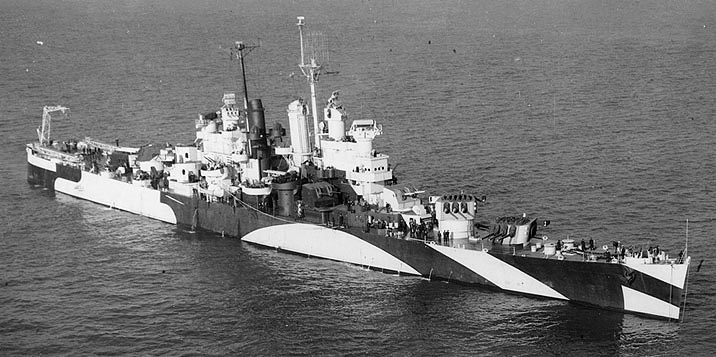
USS Houston underway off Norfolk, 12 January 1944
USS Houston was launched at Newport News Shipbuilding & Dry Dock Co. in Virginia on 19 June 1943 (originally named Vicksburg, changed 12 October 1942 for the one just sunk at the Battle of Sunda Strait). On 20 December 1942, she was commissioned with Captain William W. Behrens in command. She departed Norfolk on 1st February 1944 for her shakedown cruise in the Caribbean and headed for the Pacific on 16 April.
USS Houston arrived at Pearl Harbor on 6 May, made more training before proceeding to Majuro on 31 May, joining Mitscher’s Fast Carrier Task Force. On 5 June 1944 she was operating in the Mariana and Palau Islands. Later she took part in the battle of the philippines, and she splashed many Japanese aircraft. However she would have the occasion of some shore bombardment on Guam and Rota. Back to Eniwetok on 12 August she was prepared to join Task Group 38.2 (Rear Admiral Gerald F. Bogan). On 6 September, she supported attacks on Palau, shelled Peleliu and other islands before the landings. Strikes against airfields and shipping in the Philippines followed, and back to Peleliu landings on 17-19 September.
After rsplenishing in Ulithi in October 1944 she covered airstrikes against Okinawa. On the 12th, against Formosa. The Battle of Formosa as mostly an air battle, but USS Houston claimed four aircraft on 12 October. After USS Canberra was badly hit, Houston took over her station on 14 October and she later claimed three twin-engined torpedo bombers. However a fourth one get through and secired an aerial torpeod hit on USS Houston. Her forward engine room was flooded and she lost all four machinery space, s she became esentially dead in the water, without even electrical lighting. The crippled cruiser was approached during the night by USS Boston, which took her in tow to Ulithi. Damage control proceeding round the clock to try to recover the ship, jettisoning 122 tons of topside equipment, due to the unstable nature of these ships now fully clear to all. By noon, the 16th, the pumps had all second deck compartments dry, while third deck compartments were now watertight so she was now took care of by the fleet tug USS Pawnee.
However that day, in the afternoon, another airstrike coming from Formosa fell on USS Houston. The planes launched torpedoes, one hitting her stern, flooding her hangar while a fire started on the fuel tank. In total she had more than twenty dead or wounded sailors. The captain ordered to evacuating all non-essential crew on the escorting ships while the damage control parties stayed on board, fighting to keep the crippled cruiser afloat. “Cripple Division I” however was no attacked as the Japanese believed this was the remnants of TF 38, Admiral William F. Halsey hoping to lure them on to finish off the two damaged cruisers. When USS Houston and Canberra were out of range, they were safe and proceeded without further incident to Ulithi on 27 October 1944, missing the second battle of Leyte Gulf. Houston proceeded to Manus Island after some repairs, entered the floating dry dock for more repairs on 20 December before stealing to Pearl Harbor and from there, New York Navy Yard, arriving on 24 March 1945.
This repair was over on 11 October 1945, and the war ended in between. With a partly new crew, the cruiser made a refresher training in the Caribbean and other exercises off Newport, Rhode Island before making from 16 April 1946 a long goodwill tour of European and African ports, including Scandinavia, and back to home waters on 14 December 1946. On 17 May 1947 she joined CruDiv 12 heading for the Mediterranean. Back to Philadelphia on 16 August 1947 she was decommissioned (15 December), placed in reserve and stricken on 1 March 1959, sod for BU. She won three battle stars in WW2.
 USS Providence (CL-82)
USS Providence (CL-82)
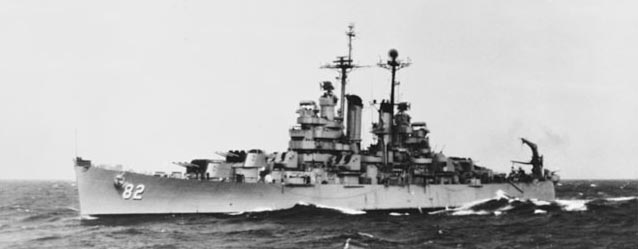
USS Providence underway, Mediterranean Sea circa 1948
USS Providence was built at Bethlehem Steel Co., Quincy in Massaschussetts, commissioned on 15 May 1945 with Capt. Thomas John Ryan in command. Departing Boston on 13 June she made a shakedown off Guantanamo Bay in Cuba and trained after a stop in Newport until 6 October, and the war ended in between. She departed Boston in November 1945 for a long cruise to the Mediterranean, visiting Piraeus, Istanbul with USS Missouri, Alexandria where she ran aground in May 1946. She departed on 16 June for Philadelphia, and after some repairs made a training cruise off Delaware Capes in October 1946 and more training out off Cuba and Norfolk before stopping at Hampton Roads for a new tour of duty in the Mediterranean, from 3 February 1947, alternating exercises and port visits and back to Boston.
She sailed Newport in November for a third tour in the Mediterranean, starting on 20 November 1947, until 2 March 1948, visiting Italy notably and was bac to Newport before her fourth tour from September 1948, with the 6th Fleet, until 14 January 1949, notably visiting Thessalonika and Marseilles, Trieste and Venice, Oran and back home, decommissioned at Boston on 14 June 1949, mothballed in the Atlantic Reserve Fleet. She was chosen for conversion in 1957, redesignated CLG–6 on 23 May 1957 and started conversion to a Providence-class guided missile light cruiser at Boston, from June. She notably operated until the end of the Vietnam war, receivinh a second Navy Unit Commendation and decommissioned on 31 August 1973.
 USS Manchester (CL-83)
USS Manchester (CL-83)

USS Manchester underway off Korea circa 1951
USS Manchester was one of the last completed Cleveland cruisers, completely missing WW2, but soldiering in Korea. Laid down on 25 September 1944, launched on 5 March 1946 and Commissioned on 29 October 1946, so she completed her shakedown cruise in the Caribbean on 26 March 1947. There she was equipped with an experimental plastic cover for her bridge to be tested on her first transatlantic crossing. On 18 April, she steamed for the Mediterranean to lend visible support to the Truman Doctrine of 12 March. She trained this summer on the East Coast for two weeks and carried the Naval Reserve training off Newport and made a Mediterranean cruise from June to November.
She completed two more deployments with the 6th Fleet in the Mediterranean, on 9 Februar-26 June 1948 and 3 January-4 March 1949 and assigned to the Pacific Fleet, arriving at Long Beach on 3 April. She sailed to Tsingtao arriving on 15 May 1948 as the Chinese civil was was going to end, to safeguard possible US interests there. She operated in the Yellow sea but also the East and South China Seas and was back to Long Beach on 28 November.
However when the Korean war broke out she was in the process of being mothballed long terme, and before than, she was in San Francisco’s drydock, in overhaul. This was sped up enough so that on 1st August 1950 she was able to steam out for the Western Pacific.
From Sasebo in Japan (early September) she joined TF 77 and commenced operations in the Yellow Sea in supporting of the UN air Forces targeting Communist communications lines. The USN enforced the naval blockade and shelled positioons along the North Korean coast. On 15 September USS Manchester was present during the landings at Inchon, bombadring coastal defences and shore installations. Next, she moved north, shelling North Korean troop concentrations on Tungsan Got, inconjunction with aviation, which also provided spotting. Her action (with the rest of the fleet) slowed down reinforcements indeed.
USS Manchester next supported the invasion at Wonsan. From 10 October she commenced bombardment and patrol duties, notably to protect minesweeping operations while TF 77 air strikes destroyed some North Korean vessels but aslo road and rail and other valuable targets as far north as Songjin. When the Yalu River was reached and the fleet prepared to sail home, USS Manchester was reassigned on 29 October to TF 72 patrolling the Taiwan Straits. As the Chinese intervened she was back on 3 December with TF 77 covering the evacuation of Hungnam. She also took part in localized shellings in support of U.N. units alog the coast, allowing their safe withdrawal.
On 8 January 1951, she evacuated injured crewmembers from the Thai corvette HTMS Prasae grounded behind enemy lines off Kisamon Tan and fire upon by shore batteries. Their evacuation was done by the USS Manchester’s helicopter. After another round of patrols off the east coast she shelled and destroyed communication and transportation centers, ammo, workshop, repair depots, troop concentrations. On 22 February she was bombarding off Wonsan the port and along the northeast coast notably off Songjin, ending her forst tour of duty there.
On 1 June, USS Manchester departed for Yokosuka and Long Beach (15 June). After five months resplenishing with the crew’s rest, she depated for her second tour of duty on 5 November 1951, arriving on 8 December, assigned to TF 95 blockading North Korea. In 1952 the blockade was soon extended to the entire Korean coast, main supply routes being all shelled, the troops soon learning to avoid narrow coastal plains and uses underground dug up caches in the mountains instead. USS Manchester blasted objectives at Chinnamp’o, Chongjin, Tong’Cho-Ri, Hungnam, Songjin, and Wonsan. Her helicopters meanwhile multiplied SAR mission inland, recovering downed pilots on land and sea, often behind enemy lines while her medical officers team worked around the clock. On 14 May 1952, USS Manchester departed to Long Beach, for repairs, overhaul and crew’s rest.
In the context of ongoing peace negociation, USS Manchester departed for her tout of duty on 25 January. On 4 Marc she was deployed with TF 77 along the east coast. First she shelled Wonsan, lternating between patrols along the coast and localized fire support for U.N. Forces. This ended on 23 July, as she departed for Yokosuka and on 27 July 1954 the Korean Armistice Agreement was signed at Panmunjom. She sailed back home, but returned soon in the volatile Pacific, making another tour in 1955 with the 7th Fleet, notably participating in Operation Glory carrying fifty unidentified American dead from Korea to Pearl Harbor. On 20 January 1956 she participating in ceremonies before heding for Long Beach, and San Francisco, laced in the Reserve Fleet on 27 February 1956, decommissioned on 27 June 1956, then stricken on 1st April 1960 and sold for BU on 31 October 1960.
 USS Vicksburg (CL-86)
USS Vicksburg (CL-86)
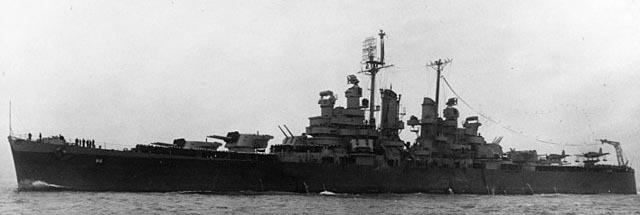
USS Vicksburg CL-86 off San Francisco October 1945
USS Vicksburg was commissioned at Norfolk Nyd on 12 June 1944, with Captain William C. Vose in command and fitted out until July, made her shakedown in Chesapeake Bay and sailed to Trinidad on 7 August, Gulf of Paria until 30 August, including shore bombardment exercises off Culebra (Puerto Rico) and back to Hampton Roads for radar spotting practice on 9 September and drone practice at Cape May on 10 September.
After her post-shakedown overhaul at Boston until 24 September, standardization trials off Rockland in Maine and taking part in the naval radiation laboratory tests off Deer Island (Boston) she made more training in Narragansett Bay, Block and Long Island Sound, as pre-commissioning training vessel unril 15 December, before heading back for maintenance at Norfolk, post-repair fixes. She departed for the Pacific at last on 1 January 1945, meeting en route USS Rodman and Emmons forming TG 21.12. to cross the canal and arrive in pearl on 17 January 1945. After exercises off Oahu she departed on 5 February for Saipan. Her first mission was Operation Detachment covering the landings on Iwo Jima.
USS Vicksburg joined TG 52.19 and on 15 February was part of Task Unit 54.9.2, covering USS Nevada and Idaho, Chester and Pensacola which later split into two fire support units. Vicksburg teamed with Chester and Pensacola, when bombarding the shore, concentrating on the northern end of the island. She refuelled at Ulithi on 5 March and later prepared for Okinawa. She was operating near Kyūshū when attacked by a Mitsubishi G4M “Betty” dropping her torpedo while she was veering in a hard turn. It missed her bow, 35 yards off, but went on alongside her port side for some time, while another was spotted which dropped flares engaged by AA.
USS Vicksburg eventually shot it while soon after a Yokosuka P1Y “Frances” approached one of the carriers from astern but was also splashed. Vicksbur shot afterwards an incoming Yokosuka D4Y “Judy”, her last victory of that day.
The raid wnet on alongside the Japanese home islands, Vicksburg having another kill the following day, and supporting other strikes before detached from TG 58.1, to take bombardment position off Okinawa. She fire in all some 2,300 main rounds and 5 inch shell for six-hour, often a few yards ahead of the Marines, which required accurate shooting. She latter supported a minesweeping operation in the East China Sea until 24 June 1945 and later remained in Philippine until the capitulation on 15 August 1945.
USS Vicksburg joined TG 38.2 on 24 August (Vice Admiral John McCain) covering the approaches to Tokyo Bay during the formal surrender, before entering the bay herself two days after.
She hosted Rear Admiral Lloyd J. Wiltse (Cruiser Division 10) as flagship and on 20 September departed Tokyo Bay with 3rd Fleet (Rear Admiral John F. Shafroth) for Okinawa, to take onboard 2,200 passengers and carrying them back home. She took part in a review in San Francisco Bay, and Navy Day on 27 October. Stopping at Long Beach she headed for Portland, Oregon on 6 November for Armistice Day and back to Long Beach, Terminal Island Naval Shipyard on 17 January 1946, overhauled and modernized. At the time she was perhaps the most modern Cleveland class cruiser. On 20 May 1946, she was flagship, Vice Admiral Frederick C. Sherman, the Commander of the 3rd Flee from Iowa. She was stationed in San Diego NAS until September and decommissioned on 30 June 1947, mothballed and stricken on 1 October 1962, sold for BU 1964.
 USS Duluth (CL-87)
USS Duluth (CL-87)
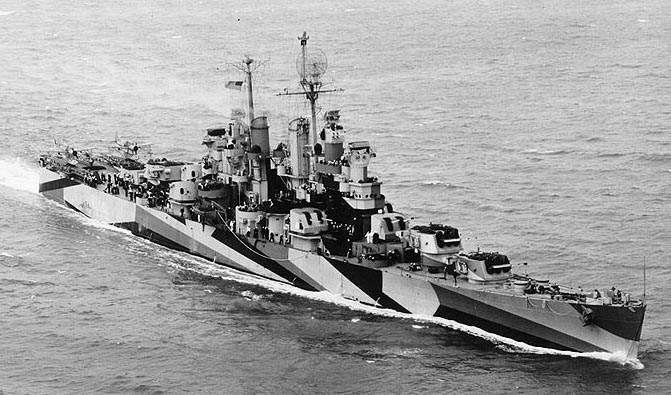
USS Duluth was commissioned on 18 September 1944 under command of Captain Donald Roderick Osborn, Jr. and from 14 December 1944 to 2 March 1945 she was training at Newport in Rhode Island. After a brief stop at Norfolk, she departed for the Pacific on 7 April and on 8 May joined the 5th Fleet. She was almost greeted pupon arrival by the storm “Cobra” and suffered severe structural damage, notably to her bow as the result, forced to return to Guam for repairs. She was back with TF 38 on 21 July to assist the final air strikes on the Japanese homeland. The war ended and she entered Tokyo Bay on 16 September. Her operations went on with TF 38, used as radar picket for the safe voyage of transport aircraft carrying occupation forces to Japan. On 1st October she departed for the United States, partipating in the 19 October Seattle’s Navy Day celebrations.
From San Pedro in Los Angeles, she returned for another tour of duty in the Western Pacific between 3 January and 27 September 1946. From 24 February 1947she was based in Pearl Harbor and made summer cruiser to Australia, visiting Melbourne and Sydney, and on her way back, Truk, Guam, and Manila, patrolling the China coast until 19 May 1948 before going back to Long Beach. She made a training cruise with midshipmen to British Columbia (summer 1948) and by February 1949, joined NATO combined operations off Kodiak in Alaska. Decommissioned on 25 June 1949 she was mothballed, until stricken in 1959, sold for BU on 14 November 1960.
 USS Miami (CL-89)
USS Miami (CL-89)
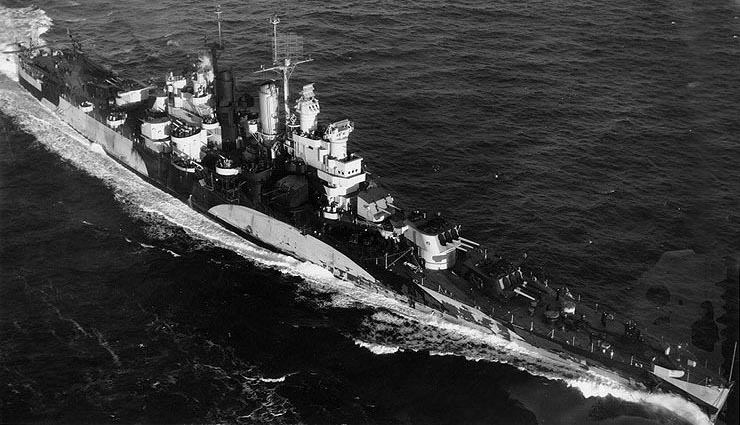
USS Miami CL-89 underway at sea circa early 1944
USS Miami was laid down 2 August 1941 at Cramp in Philadelphia, launched 8 December 1942, commissioned on 28 December 1943 (Captain John G. Crawford), making her shakedown in the Caribbean, training along the Atlantic coast notably ith her sister-ships Vincennes and Houston. All three departed Boston on 16 April 1944 for the Pacific, in Pearl Harbor on 6 May. In the Fast Carrier Task Force by June 1944, she commenced her actions against Saipan, Tinian, Rota, Guam, Pagan, and the Bonin Islands and in July, gave support west of the Marianas. In August she supported raids on Iwo Jima and Haha Jima, then resplenishing at Eniwetok. New stroked followed at Peleliu and Angaur and the Philippines until 15 September. Her scout planes were busy making SAR around the clock as well. She resplenished in Saipan on the 29th and then Ulithi, this time to cover strokes on Okinawa (10–14 October).
During the night air attack on 12/13 October USS Miami’s claimed her first enemy plane, assisting in more. She also covered a raid on Luzon on 18 October. The she took part in the Battle for Leyte Gulf. With Rear Admiral Gerald F. Bogan’s Carrier task group she protected Intrepid, Hancock, Bunker Hill, Cabot, and Independence for possible air attacks while they sent their Planes in the Sibuyan Sea on 24 October, sinking Musashi almost sinking IJN Myōkō, the remnant soon chased off by Admiral Halsey. USS Miami and sister ships managed to catch the IJN Nowaki off San Bernardino Strai, sunk for good.
After more carrier strikes in the Philippines by November 1944, Miami like the rest of the fleet was hit by typhoon Cobra shen she operated east of Luzon, on 18 December. Her hull was merely damaged by buckling and she spent the next days searched for survivors. On January 1945, she covered air strikes on Formosa, Luzon, French Indochina, South China Coast, Hainan, and Hong Kong. She engaged in an air strike against Formosa and the same day spotted and shot down an incoming Mitsubishi A6M Zero. On 1st she covered striked alongside the Japanese home islands and Tokyo area. By mid-March, USS Miami started operations off Okinawa until late April, splashing more planes.
She left Ulithi on 10 May 1945 for Pearl Harbor and San Francisco for an Overhaul starting on 24 May, until the end of the war. When she was back to Pearl Harbor it was on 25 August. September-October saw her in the Ryūkyūs and after a stop in Yokosuka she headed for Truk in November. She was back at Long Beach on 10 December and operated on the California coast with naval reservists. She was ultimately decommissioned on 30 June 1947, mothballed, Pacific Reserve Fleet until stricken on 1 September 1961, sod for BU on 26 July 1962. For her service she wons six battle stars.
 USS Astoria (CL-90)
USS Astoria (CL-90)
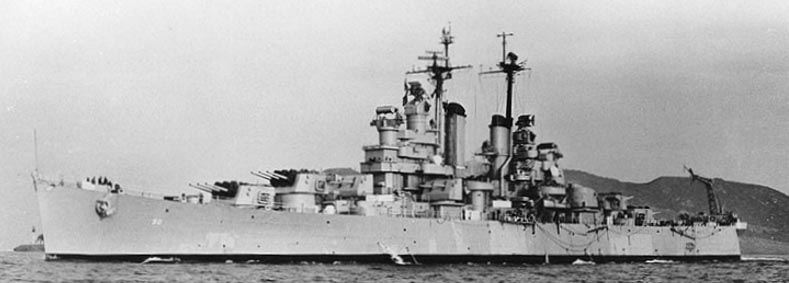
USS Astoria 1947
USS Astoria was initially laid down as Wilkes-Barre but commissioned at Philadelphia NyD on 17 May 1944, renamed and under command of Captain George Carroll Dyer. After her shakedown training off Bermuda until 23 July 1944 and post-shakedown overhaul she departed on 19 September for the Pacific. From San Diego on 3 October and Mare Island NyD she arrived in Oahu on the 31st, remaining there until 16 November, training. She departed for the Ulithi Atoll, stopping at Eniwetok en route and was assigned on arrival to TG 38.2, Fast Carrier Task Force.
USS Astoria and TF 38 sorties on 11 December 1944 during the landings on Mindoro. Later she and other ships was hit by a typhoon, weathering it fairly well. Back to Ulithi for Christmas she was underway on to provide air support for the Luzon landings (9 January 1945). On that night Admiral Halsey led TF 38 into the South China Sea to attack Japan’s inner defenses. For two weeks, raids followed on Japanese-held southern China and French Indochina, plus Formosa. USS Astoria was part of the screen. TF 38 was back to Ulithi on 25 January.
In February she was in TF 58 (Spruance) en route to pound the home islands, off Honshū on 16 February. Chi Chi Jima in the Bonins was hit and Iwo Jima the next day. Astoria closed to shore on the 21st, starting a 26-hour gunfire support before joining strikes against Tokyo and back to to Ulithi (3 March). On 14 March she joined TF 58 to capture Okinawa, remaining at sea with the fast carriers for 80 days, launching air strikes around Kyūshū, Shikoku, and Honshū and naturally Okinawa and islands around. Her AA defense claimed 11 enemy planes, assisted many others. At the end of the conquest of Okinawa she sailed to Leyte, on 1 June.
She was maintained and overhauled there with a crew’s rest and on 1 July 1945 was back screening the carriers hotting the home islands for a last time. She was in Cruiser Division 17, making night anti-shipping sweeps along the coast of Honshū; with mixed results. She was back screening on the first two weeks of August. After the Japanese capitulation, she went patrolling off Honshū with TF 38 and remained there until 3 September, not entering Tokyo Bay and rather ordered to sail to the US, arriving in San Pedro, Cal. on 15 September and remained there until 24 November. Se returned to Pearl Habor on the 30th for training and back to San Pedro in December.
The next ten months saw her training off the US Pacific coast, up north to Vancouver. On 15 October 1946 she was sent to the Central Pacific via Pearl Harbor, arriving in Guam on 2 November. She visited the Marianas, Guam and Saipan, and on the 19 Fabruary departed via Kwajalein and Pearl Harbor for home port, San Diego, arriving on 24 March.
Her service resumed until October 1948 and she proceeded to China to see the end of the Chinese civil war, visiting Tsingtao, Incheon and Pusan but also Sasebo and Yokosuka, Shanghai and back to Tsingtao. She was the last US ship leaving Shanghai early in 1949. On 16 February she departed Yokosuka for home, and on 1st July 1949 she was decommissioned, berthed with the San Francisco Pacific Reserve Fleet. On 20 May 1958 she was transferred to the San Diego Group and staye din reserve again until 1 November 1969, stricken and sold for BU. She won five battle stars for her service.
 USS Oklahoma City (CL-91)
USS Oklahoma City (CL-91)

USS Oklahoma City underway circa 1945
USS Oklahoma City was built in Cramp Shipbuilding, Philadelphia, launched on 20 February 1944, commissioned on 22 December 1944 (Captain C. B. Hunt). Ater her shakedown, she headed for the Pacific, reporting to Commander Cruisers Pacific Fleet (ComCruPac) in Pearl Harbor, 2 May 1945. She trained until 22 May before sailing to Ulithi, and joined on 6 June, Carrier Task Group 38.1. The latter was deployed in support of the Okinawa campaign. Until the end of July, she screened 3rd Fleet carriers and made a gunnery sweep on 18 July with other cruisers and destroyers against coast airfield on the home island and back in cover. On 15 August and afterwards, she patrolled off the coast of Japan and entered Tokyo Bay on 10 September. USS Oklahoma City remained with the occupation force until 30 January 1946, and departed for San Francisco, where she arrived on 14 February, and entered Mare Island Navy Yard on 15 August 1946 for inactivation. On 30 June 1947, she entered the US Pacific Reserve Fleet. Chosen for conversion in 1956, she was rebuilt in 1957–1960, recommissioned on 7 September 1960 (CLG-5) as a missile cruser, until decommissioned again and stricken on 15 December 1979, BU afterwards.
 USS Little Rock (CL-92)
USS Little Rock (CL-92)

USS Little Rock, Valparaiso 1946
USS Little Rock was built in William Cramp & Sons Shipbuilding in Philadelphia. Launched 27 August 1944, she was commissioned on 17 June 1945 (Captain William E. Miller). After her shakedown off Cuba plus training along the Atlantic coast she departed on 21 October for South America, sinece the war has ended a month prior. She made a five-month cruise before going back to Norfolk on 23 March 1946. After exercises off the east coast and Caribbean, she started a goodwill cruise in Europe on 4 June with 6th Fleet before heading back for Norfolk on 27 September 1946. In November 21–27 she escorted USS Missouri to Davis Strait as part of Task Group 20.2, also assisted by USS Fechteler (DD-870). Until December 4, she took part cold-weather exercises between Greenland and Baffin Island, firing star shells off the port side of Missouri for illumination. There was however a misfire, and the round after cookeingoff struck Missouri on her signal bridge, killing Coxswain Robert Fountain, starting a fire. From September 1946 to 1949 USS Little Rock also took part in east coast exercises, making tours in Caribbean and the Mediterranean. She was decommissioned on 24 June 1949, Atlantic Reserve Fleet NyC. She exited her mothball to be converted as a missile cruiser in 1959-60.
About USS Little rock as exhibited today: This is a Little Rock class guided missile cruiser, not an original Cleveland class as it would have cost too much for a conversion. It made no sense either on HMS Belfast. She was kept in Philadelphia, PA. and in 1960 taken in hands to be converted at New York Shipbuilding Corporation, Camden, NJ. She was ultimately Decommissioned November 1976. USS Little Rock was the first ship to bear the name of Little Rock, Arkansas in USN history. She is also the only guided missile cruiser on display in the U.S. today. Precious, as the sole survivor of the Cleveland class, she made four cruises to the Mediterranean and two to the North Atlantic and served as flagship for the Second and Sixth fleets. On display at Buffalo’s park she plays active parts in educational and entertaining activities such as overnight encampment programs and other events.
 USS Galverston (CL-93)
USS Galverston (CL-93)

USS Galveston tugged to the Philadelphia Naval Shipyard 24 May 1946
Built at Philadelphia NyD, launched on 22 April 1945 her construction was suspended when nearly complete, on 24 June 1946, her hull assigned to the Philadelphia Group, Atlantic Reserve Fleet. Reclassified CLG-93 on 4 February 1956 and CLG-3 on 23 May 1957 she was recommissioned at Philadelphia 28 May 1958 (Captain J. B. Colwell in command) and reconstructed as a Galveston-class guided missile light cruiser. She will be seen more in detail in a cold war post about this class.
 USS Amsterdam (CL-101)
USS Amsterdam (CL-101)
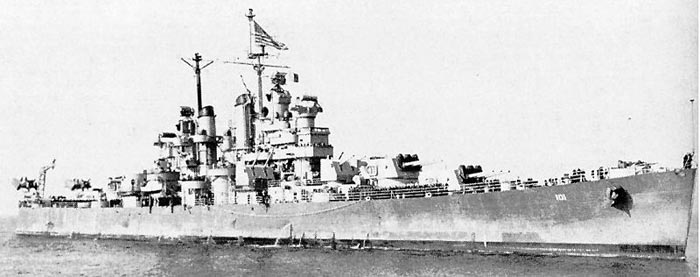
USS Amsterdam Astoria 14 October 1945
USS Amsterdam made her fitting out at Norfolk and departed on 5 February 1945 for her shakedown cruise and training in the Chesapeake Bay. On 17 February she headed south for Trinidad and trained there until 13 March, then back to Norfolk, making gunnery training off the island of Culebra underway. After gunnery exercises at Cape May, New Jersey, she left Norfolk on 20 April for more training exercises in Chesapeake Bay, the Caribbean, Cuba, and headed for Panama, ultimately reaching Pearl Harbor on 18 May for more training, before departing at last on 9 June for the Philippines.
She was at San Pedro Bay, reporting to the 3rd Fleet, Task Force 38, covering air strikes against the Japanese home islands. On 10 July she also shelled Japanese airfields, factories, and shipping. USS Amsterdam assisted the fast carriers force also against air attacks along the way. Tokyo, Kure, Kobe, and Osaka were hit, but on 15 August 1945, Japan’s capitulation was known. She participated in the occupation of Japan the following months, and was in Tokyo Bay on 5 September, carrying personnel back home to Portland, Oregon and aprticipating in Navy Day ceremonies. Back in San Pedro and upkeep she left on 19 November for Pearl Harbor. After another run with personal back to the US, she headed for San Francisco, prepared for inactivation, Pacific Reserve Fleet, decommissioned on 30 June 1947. USS Amsterdam (which won no battle star), was struck on 2 January 1971, sold and BU that year.
 USS Portsmouth (CL-102)
USS Portsmouth (CL-102)

USS Portsmouth, 22 April 1948
USS Portsmouth was built at Newport News Shipbuilding & Dry Dock Company in Virginia, launched on 20 September 1944 and commissioned 25 June 1945 with Captain Heber B. Brumbaugh in command. Her service in wartime was brief indeed. After her shakedown off Cuba the war ended and she was in Norfolk, employed with the Operational Development Force until the spring of 1946. By May 1946 she made a goodwill cruise to Africa, visiting Cape Town, Lagos, Freetown, Monrovia, Dakar, and Casablanca and entering the Mediterranean, stopping in Naples, Palermo and heading home.
On 25 November, she was back in the Mediterranean and notably Trieste until February 1947. In April she was back home and returned in November 1947 before an overhaul in Boston until 11 March 1948. She took part in exercises off the eastern seaboard and trained the Naval Reserve in the the Caribbean. On 9 March 1949, she entered the Philadelphia NyD for inactivation, decommissioned on 15 June 1949, Atlantic Reserve Fleet. In 1970, two of her main engines were retired and are still in service today as part of the MARF (Modifications and Additions to a Reactor Facility), for the S7G nuclear reactor prototype of Ballston Spa, while the rest of the ship was BU.
 SS Wilkes Barre (CL-103)
SS Wilkes Barre (CL-103)
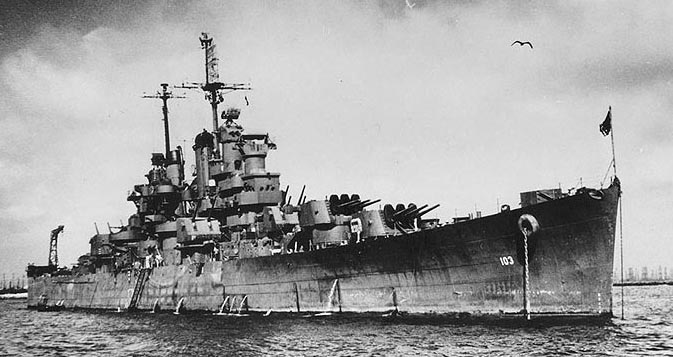
USS Wilkes-Barre circa 31 January 1946
Laid down on 14 December 1942 in NyC, launched 24 December 1943, she was commissioned at the Philadelphia NyD on 1 July 1944 with Captain Robert L. Porter, Jr., in command. After her shakedown cruise in Chesapeake Bay and Trinidad in the British West Indies, some fixes back in Philadelphia she was at sea on 23 Octobe for extensive training before heading for the Pacific. After a stop at San Diego in California, she loaded provisions and ammunitions, and made gunnery exercises off San Clemente Island, fully combat ready for 10 November 1944. She arrived at Pearl Harbor on 17 November 1944 and until 2–3 December. She sailed on 14 December for the Carolines. Stopping at Ulithi she joined Cruiser Division 17, part of Task Group 38.2 (Vice Admiral John S. McCain), the Fast Carrier Task Force (TF 38, Third Fleet). Her first sortie was on 30 December, for the South China Sea raid (Operation Gratitude). She sailed off Formosa and Luzo. There, USS Wilkes-Barre screened carriers hitting Formosa and Luzon on 3–9 January 1945. On 12 January, with CruDiv 17 she was reassigned as TG 34.5 and headed for Cam Ranh Bay in French Indochina. Back to TF 38 raids resumed on 15–16 January on Hainan Island, Indochina, Hong Kong, and Formosa until 21 January. After replenishment and repairs at Ulithi, TF38 was back into action, but now as TF 58.
By then the Fast Carrier Task Force was under command of Vice Admiral Marc A. Mitscher, still atttached to the 5th Fleet, rotating admirals and staff within the composite TF 38/58. USS Wilkes-Barre as part of CruDiv 17 was attached to TG 58.3 (Rear Admiral Frederick C. Sherman) around USS Essex. They operated off Honshū and raided Tokyo on 16–17 February 1945. On 19 February, she was off Iwo Jima, providing naval bombardment and air cover for invasion and turning back by herself a Japanese counterattack against the Marines.
When TG 58.3 separated from TF 58 on 23 February Wilkes-Barre followed the carriers raiding Tokyo and Okinawa until 1st March. After a stop at Ulithi she returned for exercises with TF 59. She operated east of Okinawa while new air striked were launched on Kyushu on 18–19 March. On 19 March, USS Wilkes-Barre repelled an air attack, splashing her first aircraft, a Yokosuka D4Y “Judy”. Her duty went on with TG 58.3 around Okinawa and she had her OS2U Kingfisher seaplanes deployed daily in efficient SAR missions, rescuing downed pilots. She alater shelled the airfield at Minami Daito.
On 1st April, USS Wilkes-Barre supported the amphibious landings of Okinawa. On 11 April her AA gunners downed three A6M “Zekes” and an Aichi D3A “Val”, assisting with two more “Zekes”. Her group made another raid on southern Kyushu, and she shot down a bomber and a “Zeke”. On 10 May 1945, CruDiv 17 was detached from TG 58.3 to shell Minami Daito Shima airfield again. When USS Bunker Hill was hit by Kamikaze, Captain Porter brought USS Wilkes-Barre alongside her, the bow hard against the carrier’s starboard quarter. Along with three destroyers she had all fire hoses pouring water on the ongoing fires and later transferred fire-fighting gear as well as rescue breathing apparatus, handy-billies to Bunker Hill, also evacuating personal. After four hours of effort she cleared Bunker Hill, saved;
On 12 May she traveled to Kyushu in cover of more strikes on airfields but the 14 she had apparently a firendly fire shell bursting and wounding nine, on the after signal bridge. She plashed also another A6M. On 28 May she was under command of Vice Admiral John S. McCain completing her tour off Okinawa and home islands and was detached from TG 38.3 on 29 May to join San Pedro Bay for repairs, upkeep, and replenishment nd then some extra training until late June;
Her last sortie on Leyte Gulf was on mid-July with CruDiv 17 striking Hokkaido and Honshū and antishipping sweeps off northern Honshū and Kii Suido. On 24–25 July they shelled the Kushimoto seaplane base and Shionomisaki airfield and patrolled there until mid-August. On 27 August her division arrived off Tokyo Bay and Wilked Barre entered it on 3 September. To that point she won 4 Battle stars.
Operations followed in connection with the occupation of Japan and she was later affected to Tsingtao, China and headed back to the US at the end of the year. She was in San Pedro on 30 January 1946, headiong on 4 March for the east coast via Panama, heading for Philadelphia, the Gulf of Mexico, and New Orleans for Navy Day 27 October 1946. She trained off Cuba with Dayton and Providence and after a stop at Norfolk in December she made a goodwill cruise to England and Norway, operating there in March-April 1947. She was placed at her return at the United States Reserve Fleet in Philadelphia. Still in mothball she was struck on 15 January 1971, but sunk as target on 12 May 1972, off the Florida Keys.
 USS Atlanta (CL-104)
USS Atlanta (CL-104)
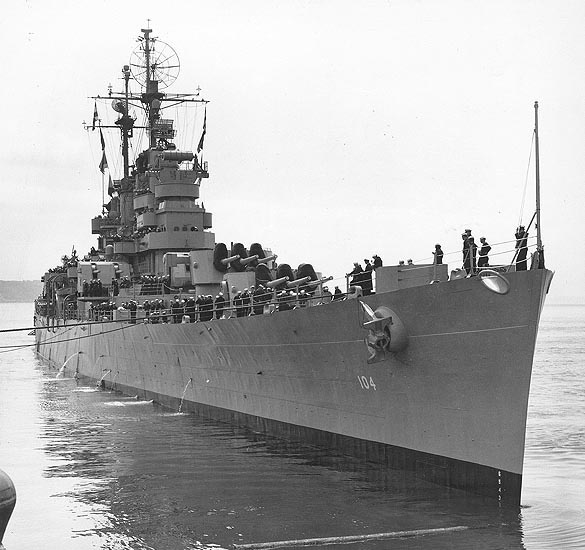
USS Atlanta June 1948
USS Atlanta, launched 6 February 1944, was commissioned on 3 December 1944 with Captain B. H. Colyear in command. On 5 January 1945 she made her shakedown training in the Chesapeake Bay and Caribbean, headed for Norfolk, then Philadelphia and sailed on 27 March for the Pacific, stopping at Guantánamo Bay in Cuba, reaching Pearl Harbor on 18 April. Until 1st May, she prepared for the campaign, making training exercises before heading for Ulithi, assigned to Task Force 58. On 22-27 May 1944 she served with the Fast Carrier Task Force south of Okinawa. Raids on Ryukyu Islands and Kyūshū followed. She was detached on 13 June, sent to San Pedro Bay in Leyte followed by two weeks of upkeep and new assignment on 1 July with TG 38.1, covering more raids over the home islands. She also took part in shore bombardment on Honshū and Hokkaidō. She was off the coast of Honshū when hearing about the surrender on 15 August 1945, entering later on 16 September Tokyo Bay. She won two battle stars for her service. After some occupation time in 1946 and two runs with allied POWs on board, she still operated in the pacific in 1947-48 and in home waters training naval reservists by early February 1949 between San Diego and San Francisco. On 1st March she entered Mare Island NyC for her deactivation, decommissioned on 1st July 1949, Pacific Reserve Fleet.
However she was not stricken an BU like the others but underwent extensive modifications at San Francisco Naval Shipyard. She became IX-304 on 15 May 1964, converted as a modern target ship to study effects of high energy air explosions on modern ships. Her hull was cut down to the main deck level and various experimental superstructures were erected on her deck, mimicking guided missile frigates and guided missile destroyers structures. Explosions and examinations follow, to determine materials, between lightness, strength and blast resistance, off the coast of Kahoolawe, Hawaii, 1965, “Operation Sailor Hat”. She was back to Stockton in California later in 1965, struck on 1 April 1970 and sunk during another explosive test off San Clemente Island in October.
 USS Dayton (CL-105)
USS Dayton (CL-105)

USS Dayton underway at sea in 1945
USS Dayton (CL-105) was launched 19 March 1944 at Camden NYc, commissioned 7 January 1945 un command of Captain Paul William Steinhagen. It was partly funded by City of Dayton (Ohio) war bonds. After initial trials, training and shakdown crusie, she arrived in Pearl Harbor 15 May 1945 before heading for San Pedro Bay, Leyte, arriving on 16 June; Assigned to the 3rd Fleet sortied on 1st July to cover the final strikes along the Japanese coast. As usual she operated with the fast carrier task groups and also made shore bombardments. She was present in Tokyo Bay 10 September and stayed as an occupation naval force until 7 November 1945, heading for San Pedro in California.
After a crew’s rest and resupply, she sailed on 24 January 1946 to Pearl Harbor and headed for Japan before being ordered to the U.S. Atlantic Fleet. After training at Guantanamo Bay she sailed for Norfolk, and was on station there until February 1947, depaerting for a tour of duty in the Mediterranean. She stopped in Malta and made a diplomatic visit to Istanbul. After going back home she returned in the summmer of 1947. She became there flagship of the Commander of Naval Forces, Mediterranean, or COMNAVMED.
She was in Bari (Italy) to load rockets needed to protect Trieste from Yugoslavian-related insurgents. Her implication wih the events there was particularly vivid in October 1947 with a frank “gunboat” policy, forcing to pass on the city to the Italian government. Citizens demonstrate in favor of this decision and surged onto the pier where Dayton was moored to greet her. She sailed to Venice and dropped anchor at San Marco Square, also feasted. She back to Trieste and headed afterwards for Boston on 30 November. She made some trainign home and another cruise to the Mediterranean (9 February-26 June 1948) before being decommissioned in Boston, 1st March 1949, long term rerserve until stricken on 1st September 1961 sold for BU 1962.


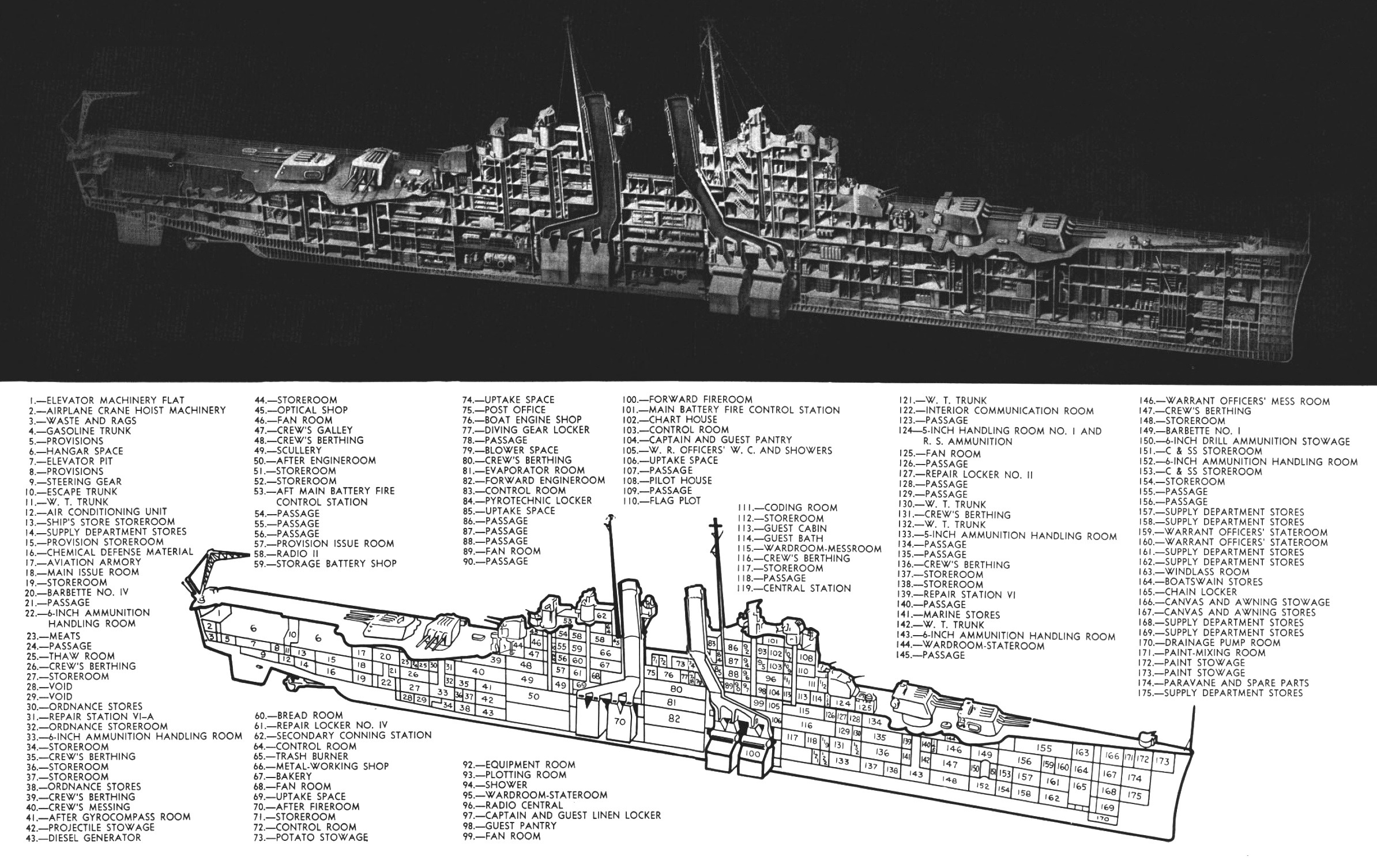
 Latest Facebook Entry -
Latest Facebook Entry -  X(Tweeter) Naval Encyclopedia's deck archive
X(Tweeter) Naval Encyclopedia's deck archive Instagram (@navalencyc)
Instagram (@navalencyc)





 French Navy
French Navy Royal Navy
Royal Navy Russian Navy
Russian Navy Armada Espanola
Armada Espanola Austrian Navy
Austrian Navy K.u.K. Kriegsmarine
K.u.K. Kriegsmarine Dansk Marine
Dansk Marine Nautiko Hellenon
Nautiko Hellenon Koninklije Marine 1870
Koninklije Marine 1870 Marinha do Brasil
Marinha do Brasil Osmanlı Donanması
Osmanlı Donanması Marina Do Peru
Marina Do Peru Marinha do Portugal
Marinha do Portugal Regia Marina 1870
Regia Marina 1870 Nihhon Kaigun 1870
Nihhon Kaigun 1870 Preußische Marine 1870
Preußische Marine 1870 Russkiy Flot 1870
Russkiy Flot 1870 Svenska marinen
Svenska marinen Søværnet
Søværnet Union Navy
Union Navy Confederate Navy
Confederate Navy Armada de Argentina
Armada de Argentina Imperial Chinese Navy
Imperial Chinese Navy Marinha do Portugal
Marinha do Portugal Mexico
Mexico Kaiserliche Marine
Kaiserliche Marine 1898 US Navy
1898 US Navy Sovietskiy Flot
Sovietskiy Flot Royal Canadian Navy
Royal Canadian Navy Royal Australian Navy
Royal Australian Navy RNZN Fleet
RNZN Fleet Chinese Navy 1937
Chinese Navy 1937 Kriegsmarine
Kriegsmarine Chilean Navy
Chilean Navy Danish Navy
Danish Navy Finnish Navy
Finnish Navy Hellenic Navy
Hellenic Navy Polish Navy
Polish Navy Romanian Navy
Romanian Navy Turkish Navy
Turkish Navy Royal Yugoslav Navy
Royal Yugoslav Navy Royal Thai Navy
Royal Thai Navy Minor Navies
Minor Navies Albania
Albania Austria
Austria Belgium
Belgium Columbia
Columbia Costa Rica
Costa Rica Cuba
Cuba Czechoslovakia
Czechoslovakia Dominican Republic
Dominican Republic Haiti
Haiti Hungary
Hungary Honduras
Honduras Estonia
Estonia Iceland
Iceland Eire
Eire Equador
Equador Iran
Iran Iraq
Iraq Latvia
Latvia Liberia
Liberia Lithuania
Lithuania Mandchukuo
Mandchukuo Morocco
Morocco Nicaragua
Nicaragua Persia
Persia San Salvador
San Salvador Sarawak
Sarawak Uruguay
Uruguay Venezuela
Venezuela Zanzibar
Zanzibar Warsaw Pact Navies
Warsaw Pact Navies Bulgaria
Bulgaria Hungary
Hungary

 Bundesmarine
Bundesmarine Dutch Navy
Dutch Navy Hellenic Navy
Hellenic Navy Marina Militare
Marina Militare Yugoslav Navy
Yugoslav Navy Chinese Navy
Chinese Navy Indian Navy
Indian Navy Indonesian Navy
Indonesian Navy JMSDF
JMSDF North Korean Navy
North Korean Navy Pakistani Navy
Pakistani Navy Philippines Navy
Philippines Navy ROKN
ROKN Rep. of Singapore Navy
Rep. of Singapore Navy Taiwanese Navy
Taiwanese Navy IDF Navy
IDF Navy Saudi Navy
Saudi Navy Royal New Zealand Navy
Royal New Zealand Navy Egyptian Navy
Egyptian Navy South African Navy
South African Navy






























 Ukrainian Navy
Ukrainian Navy dbodesign
dbodesign